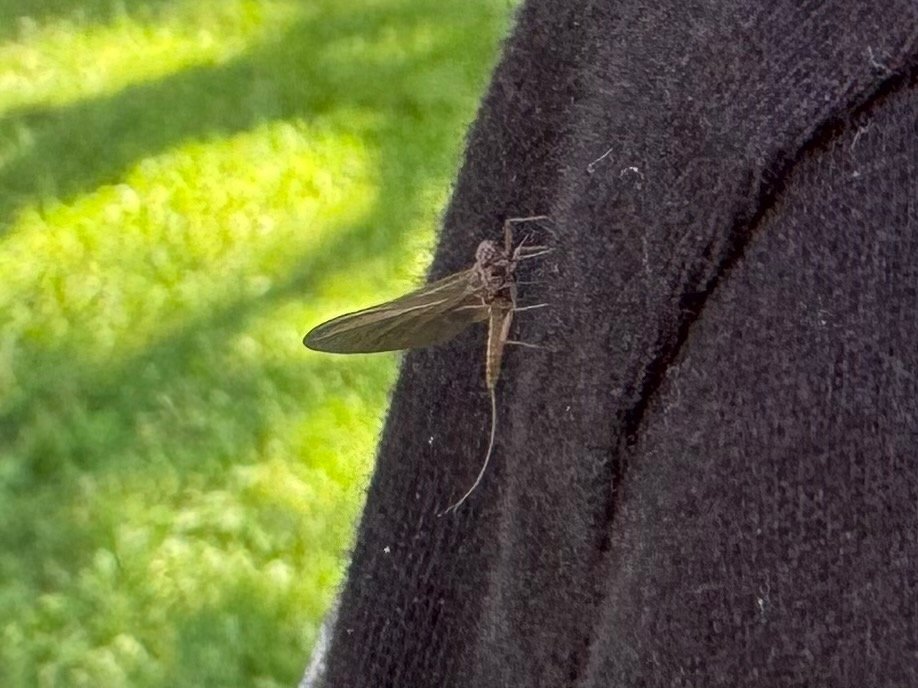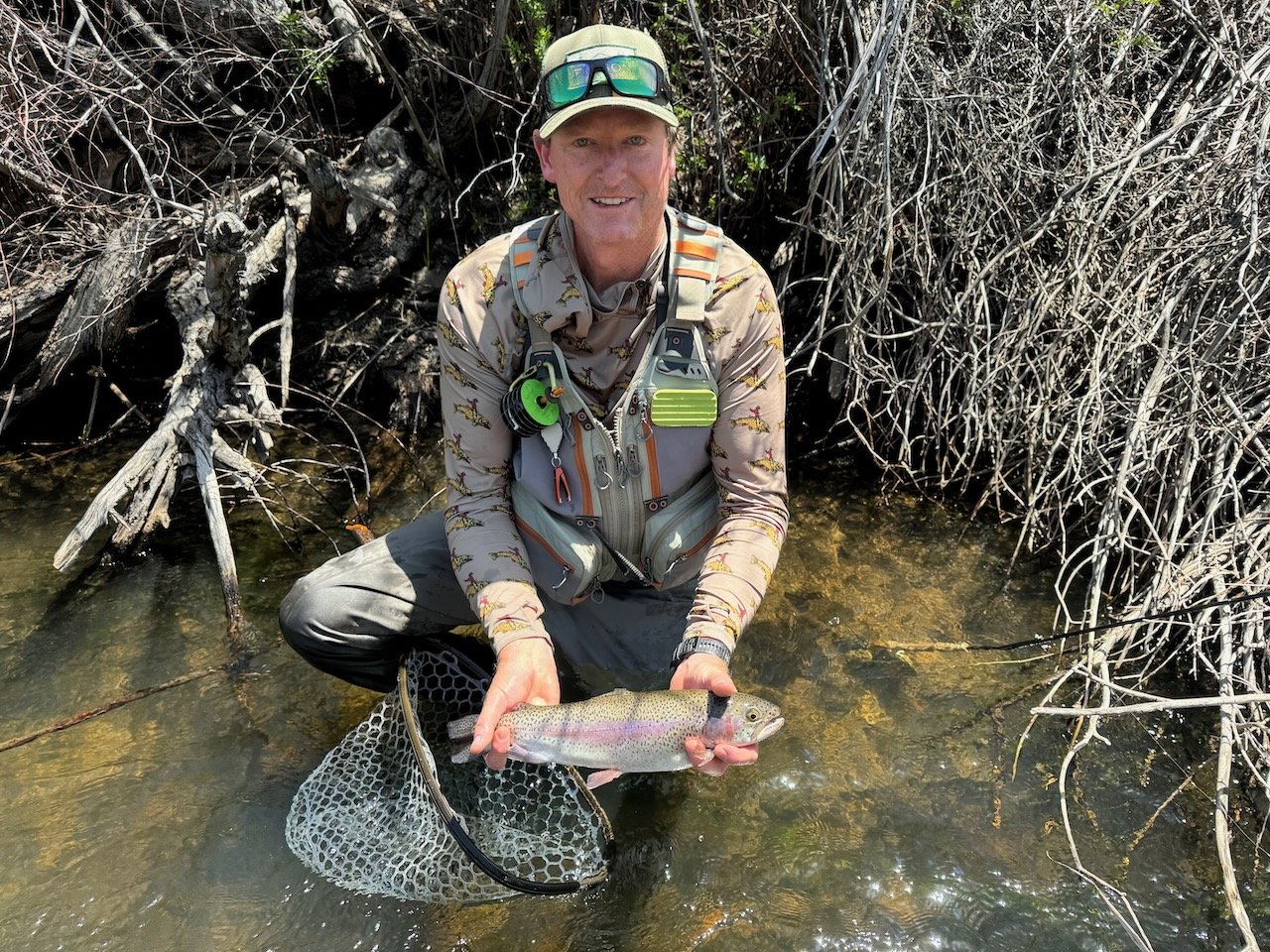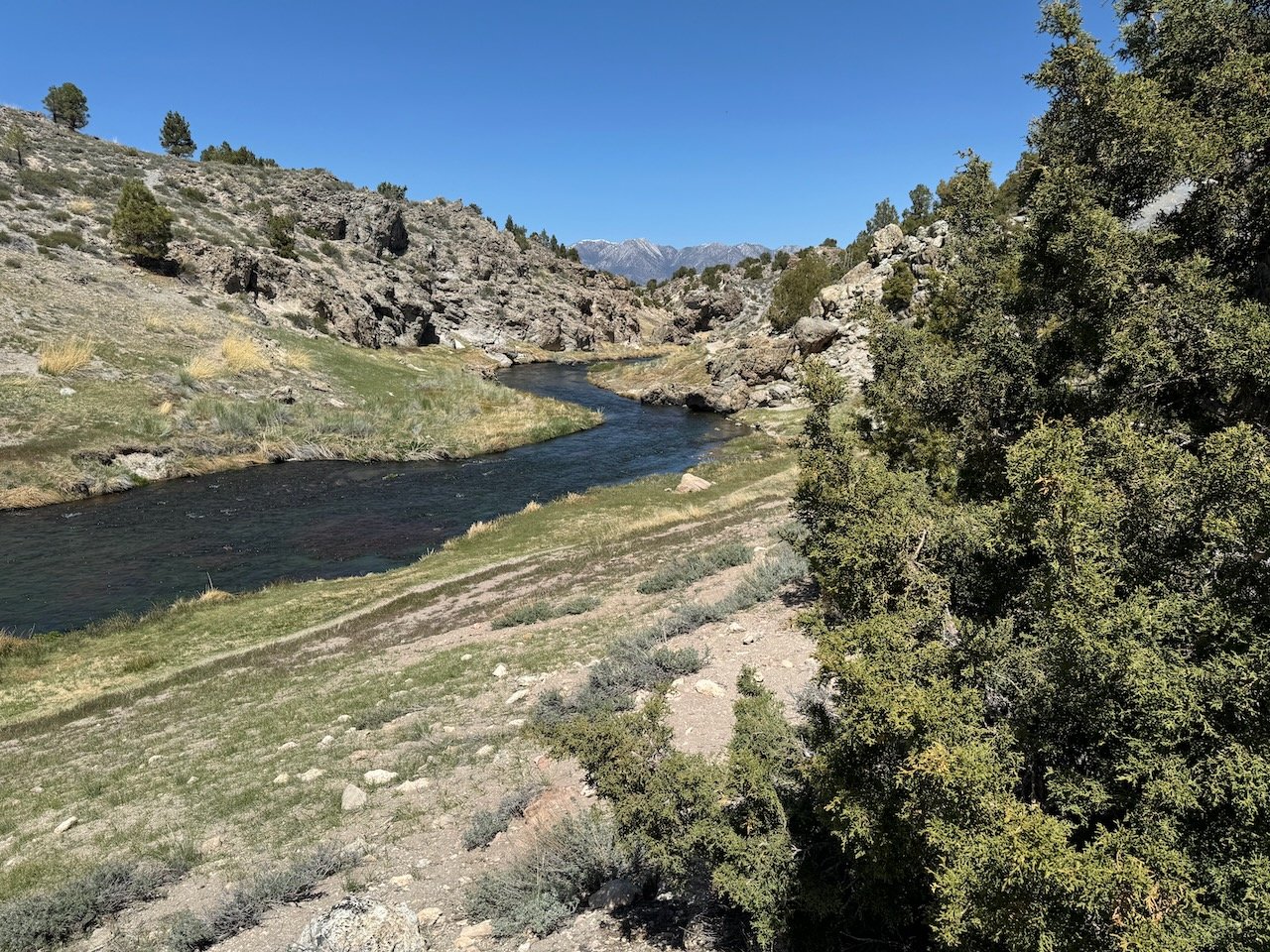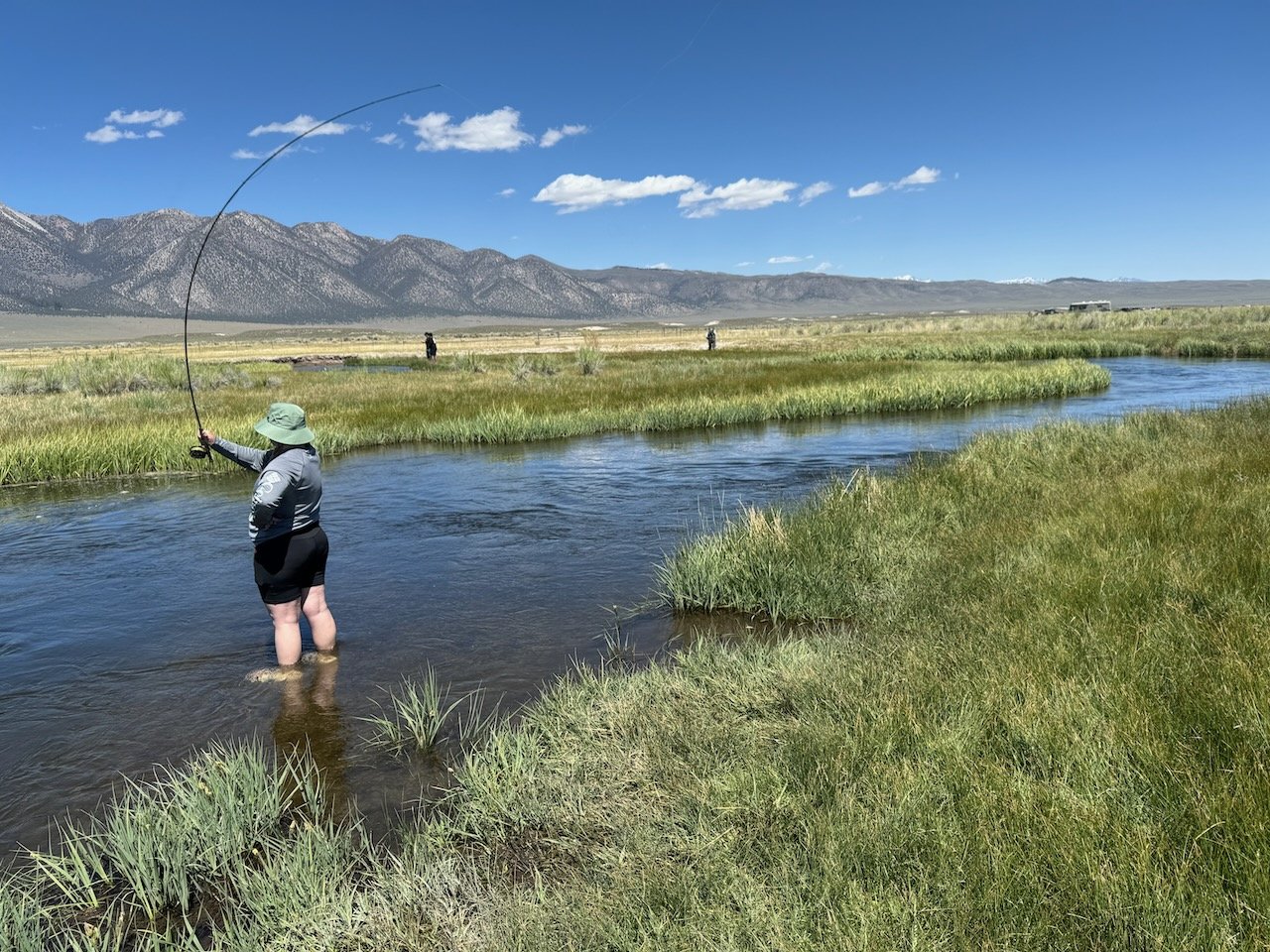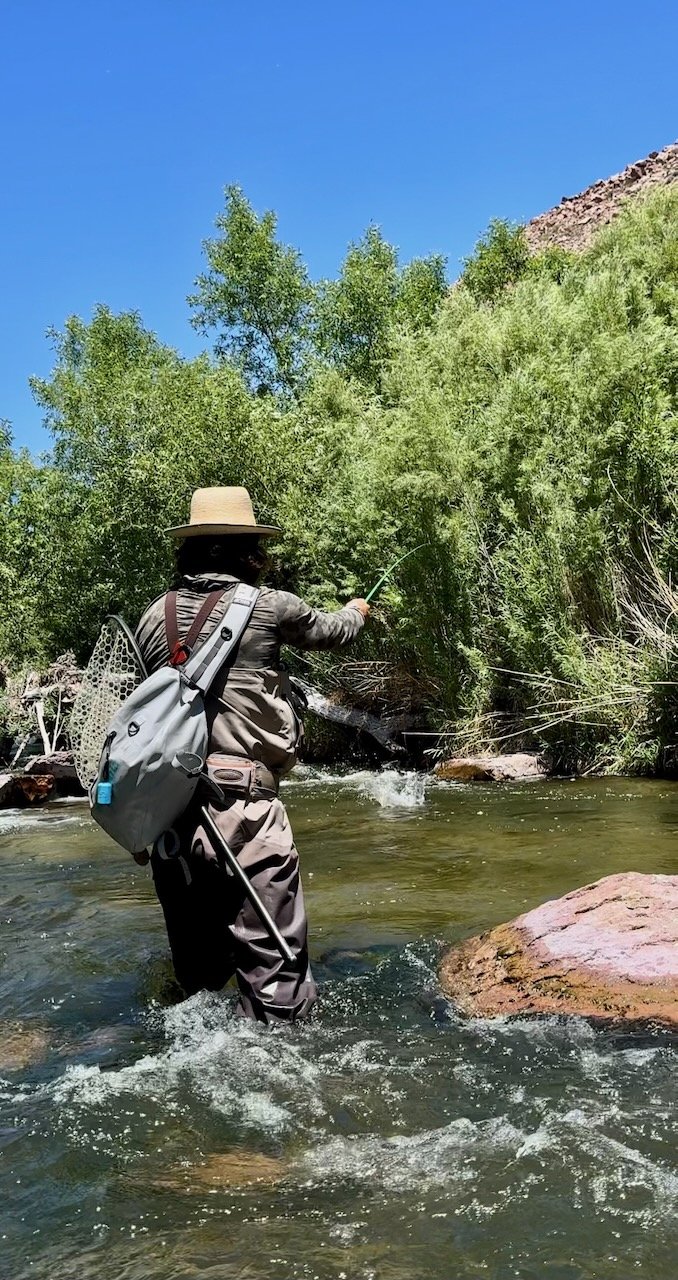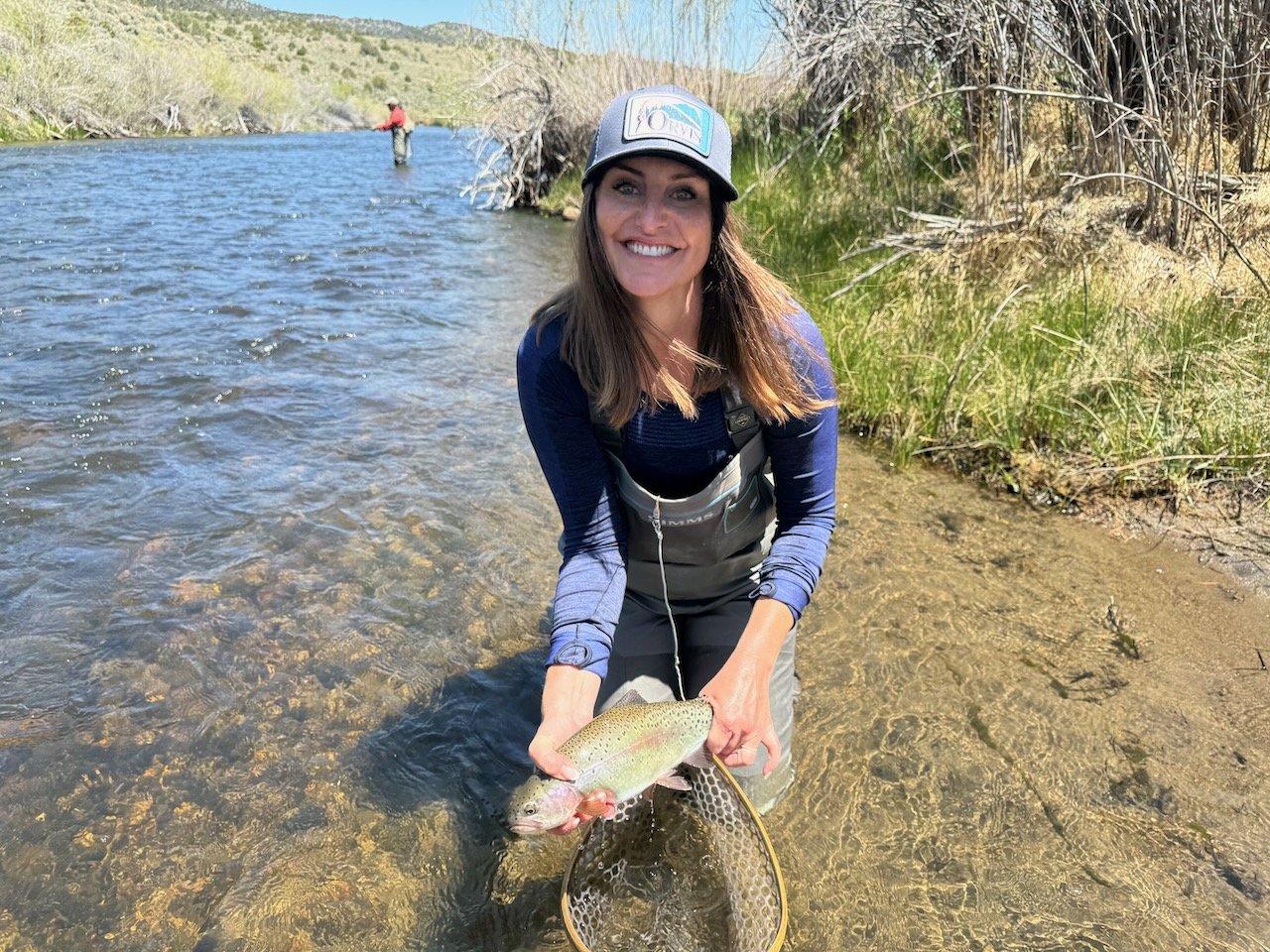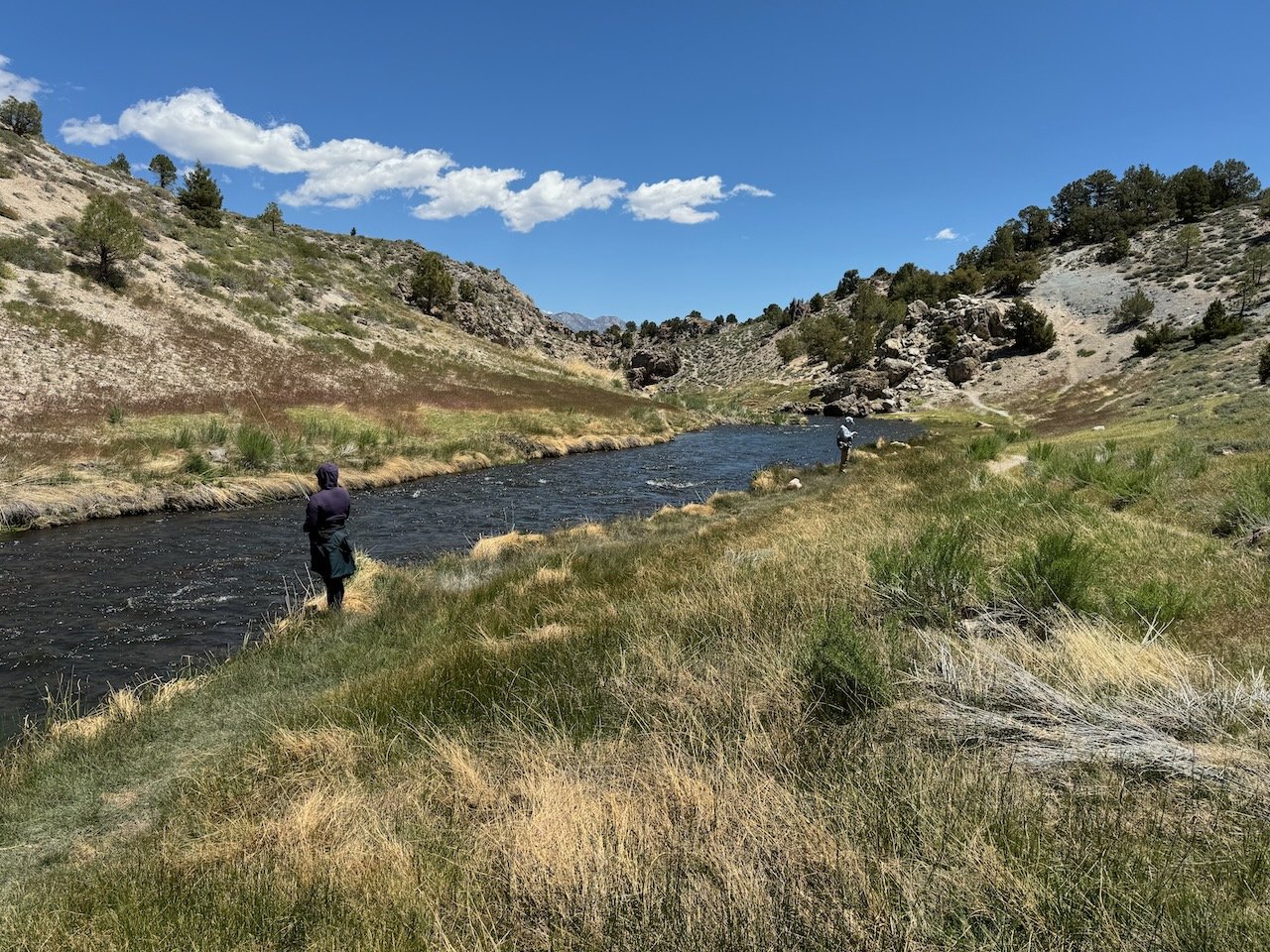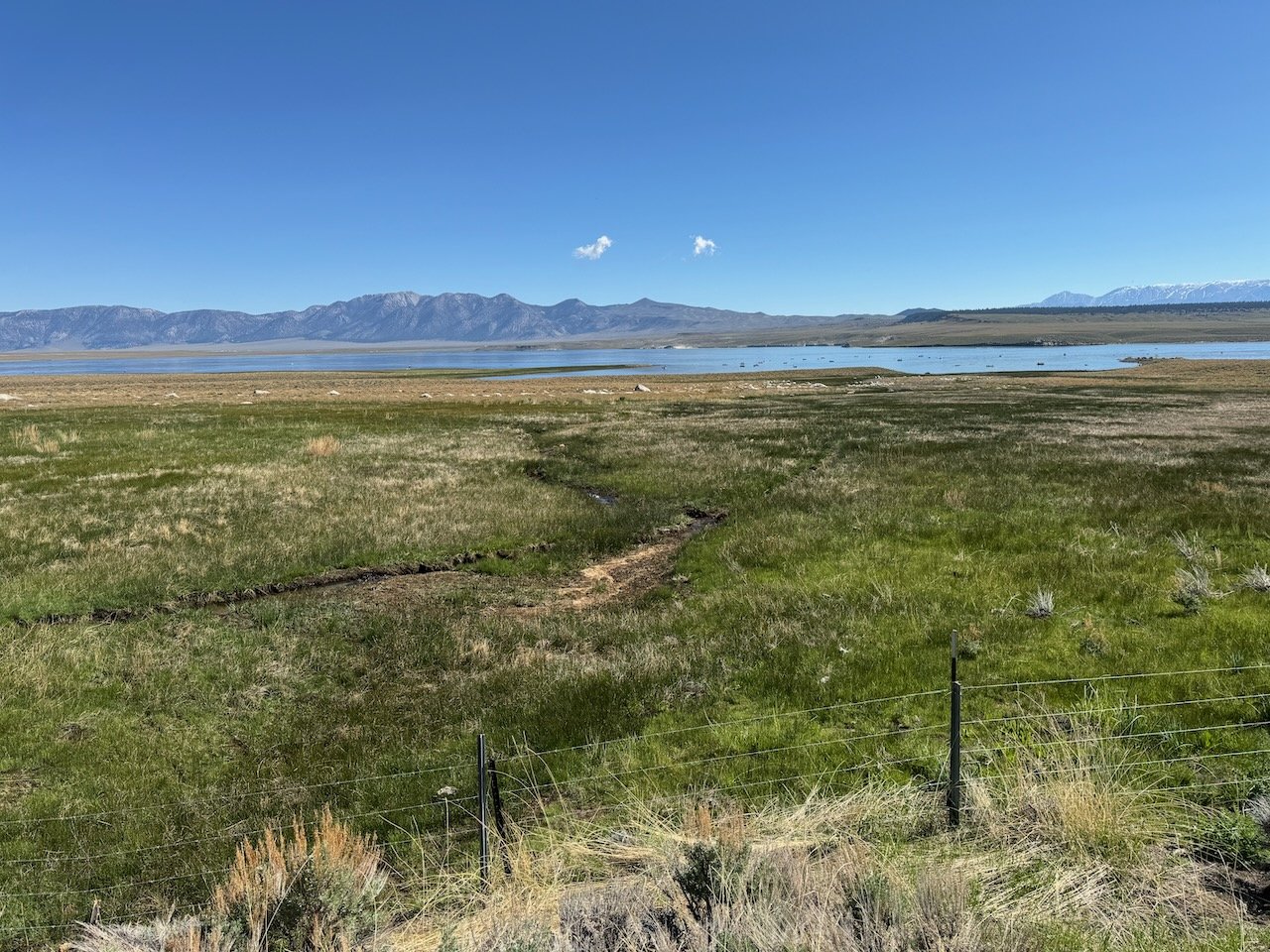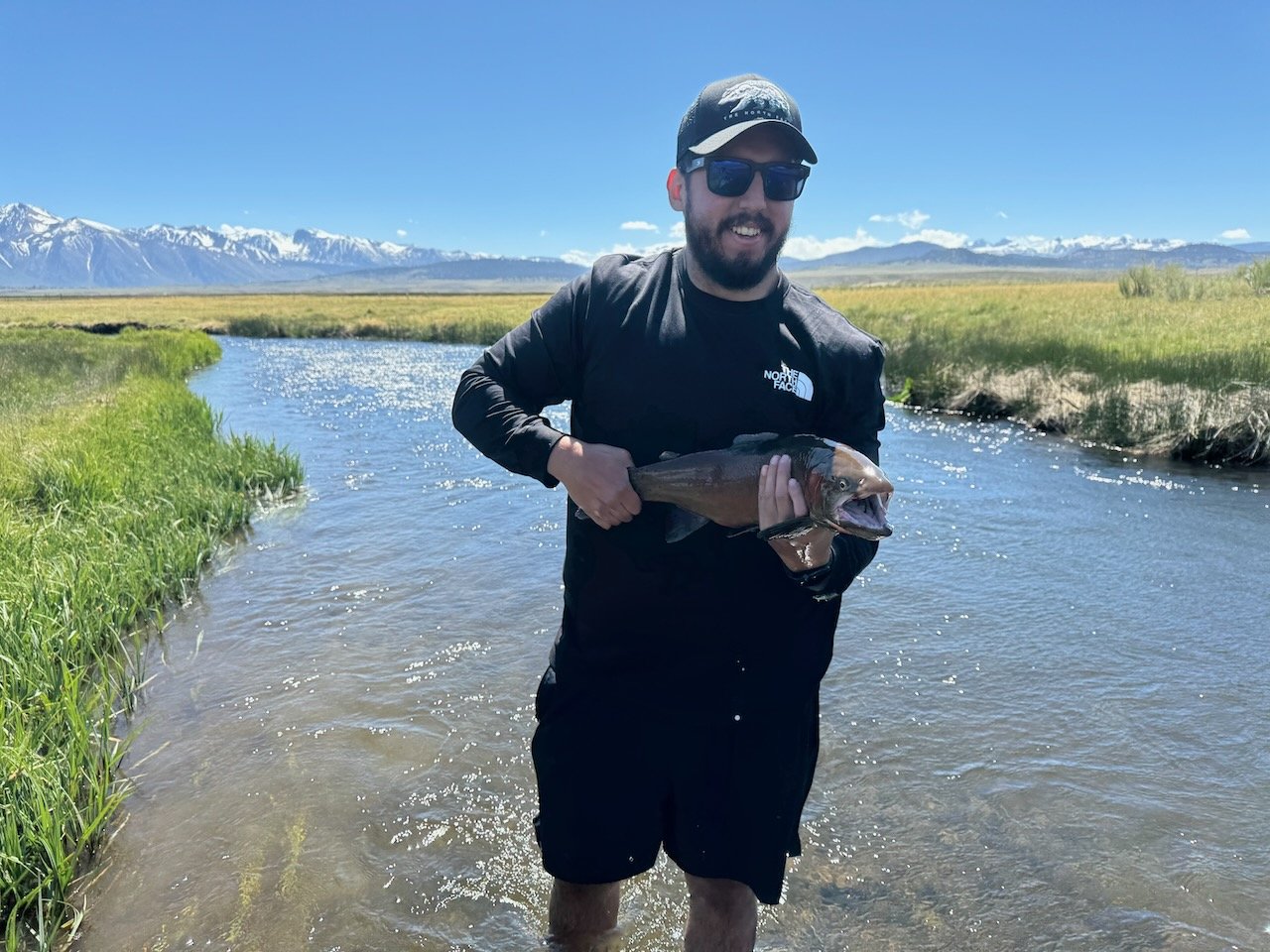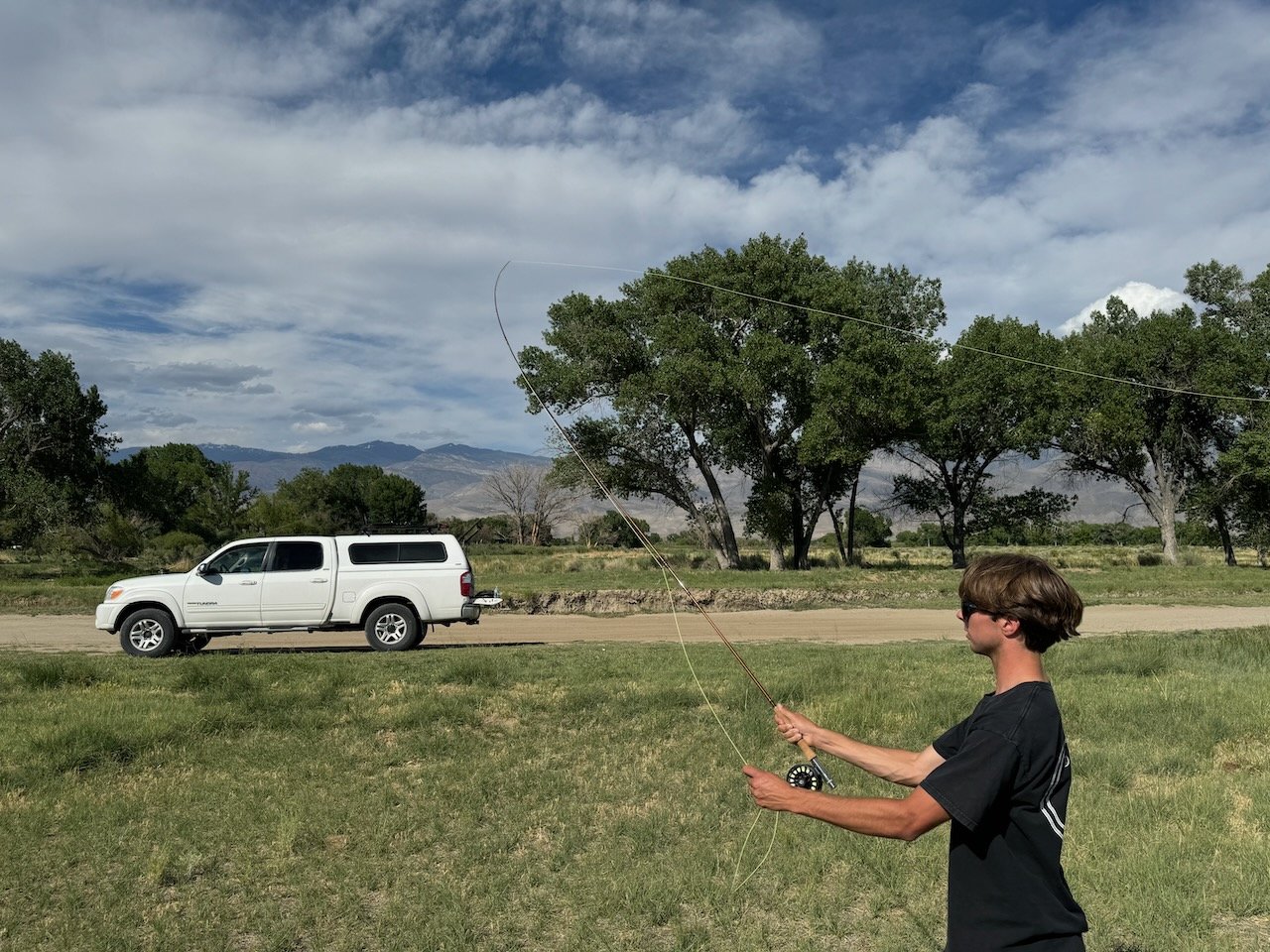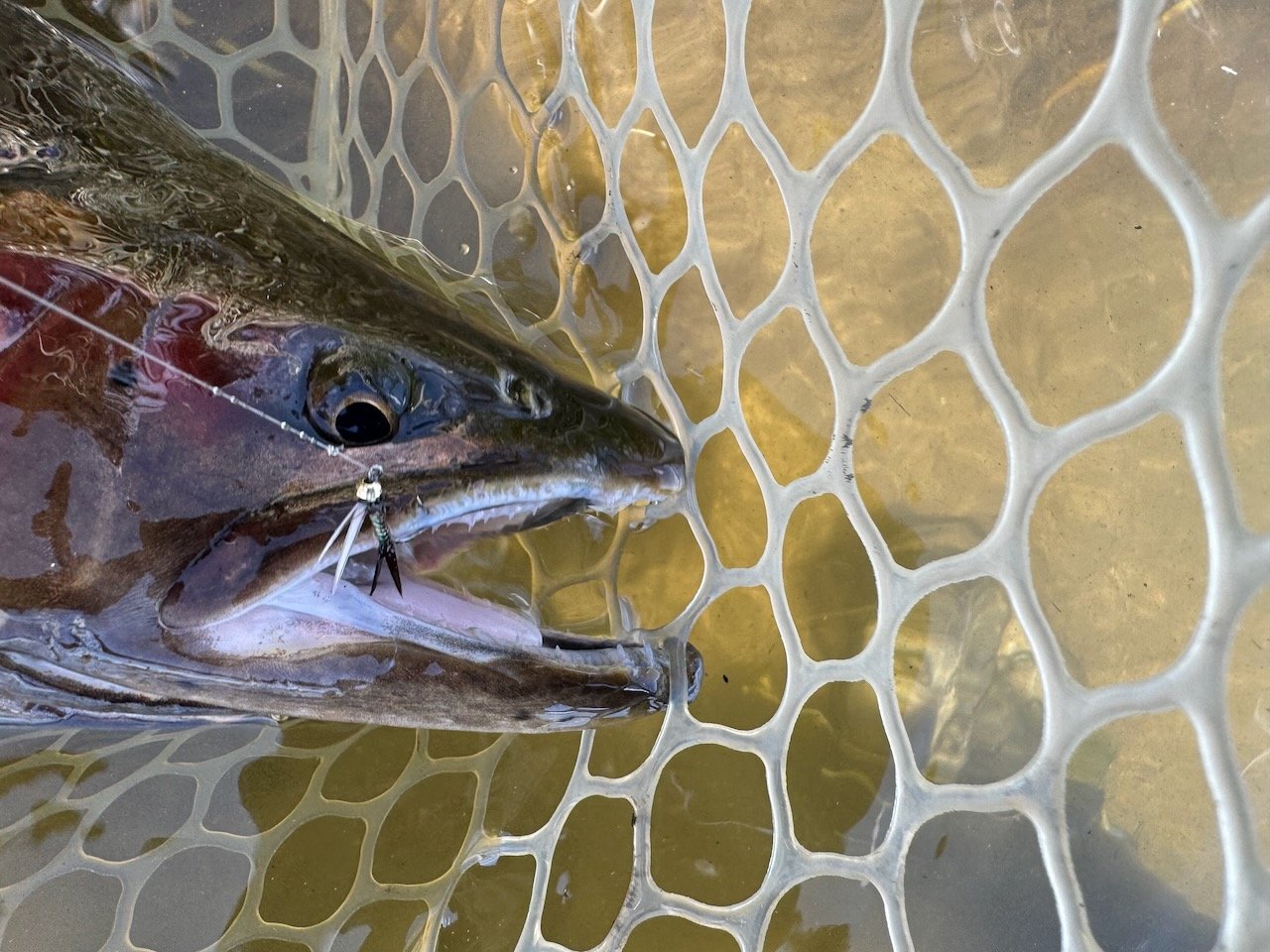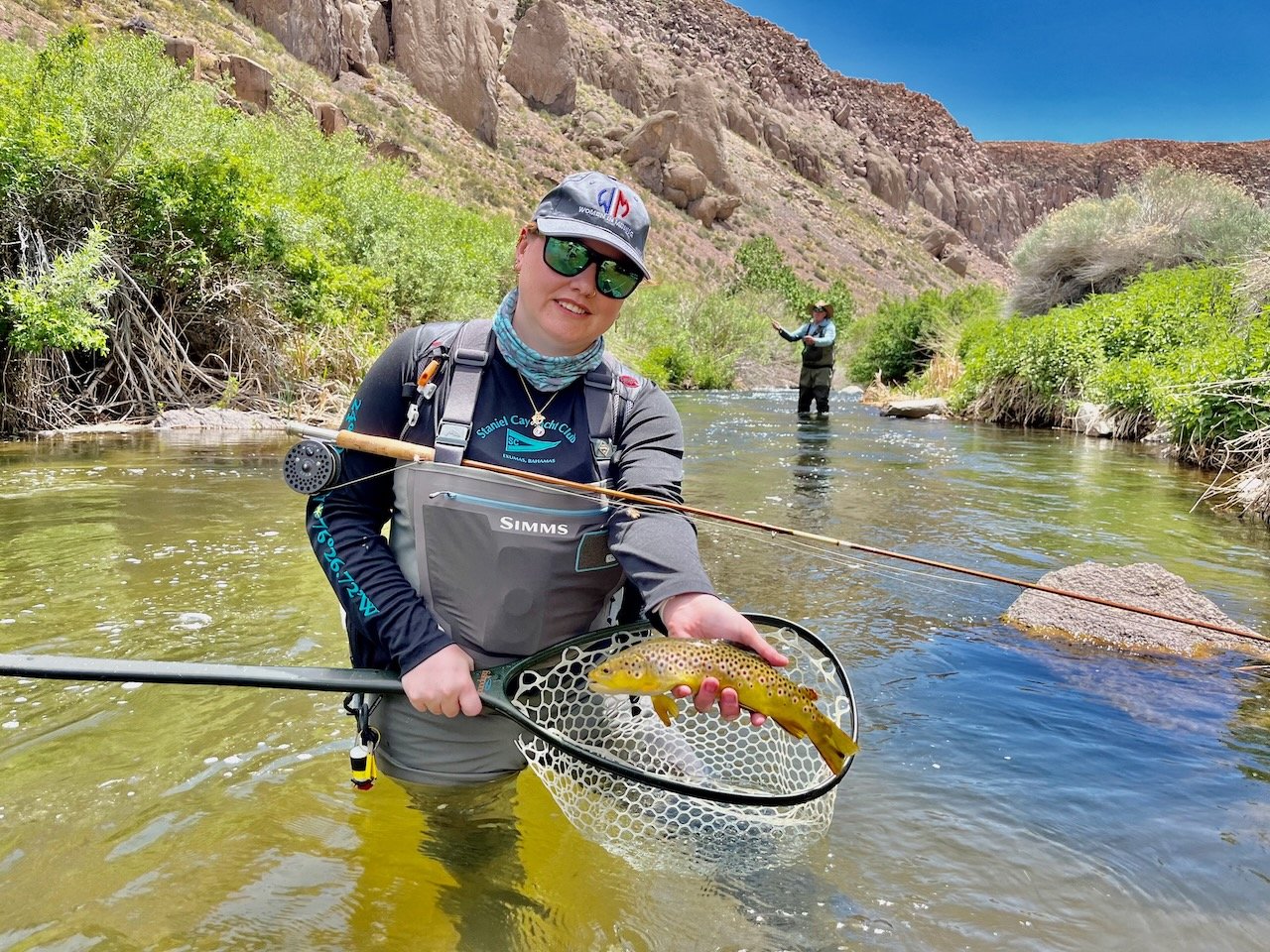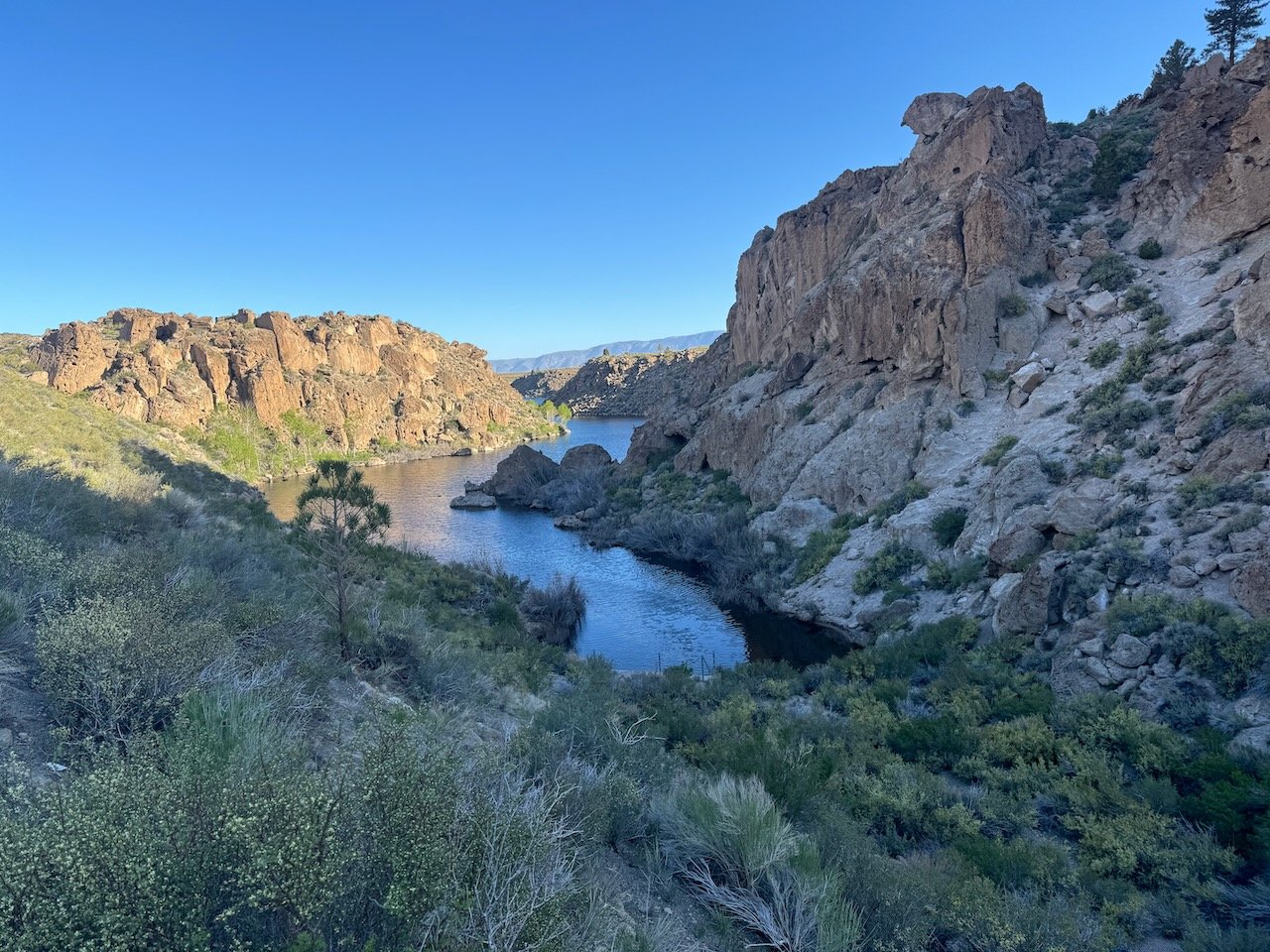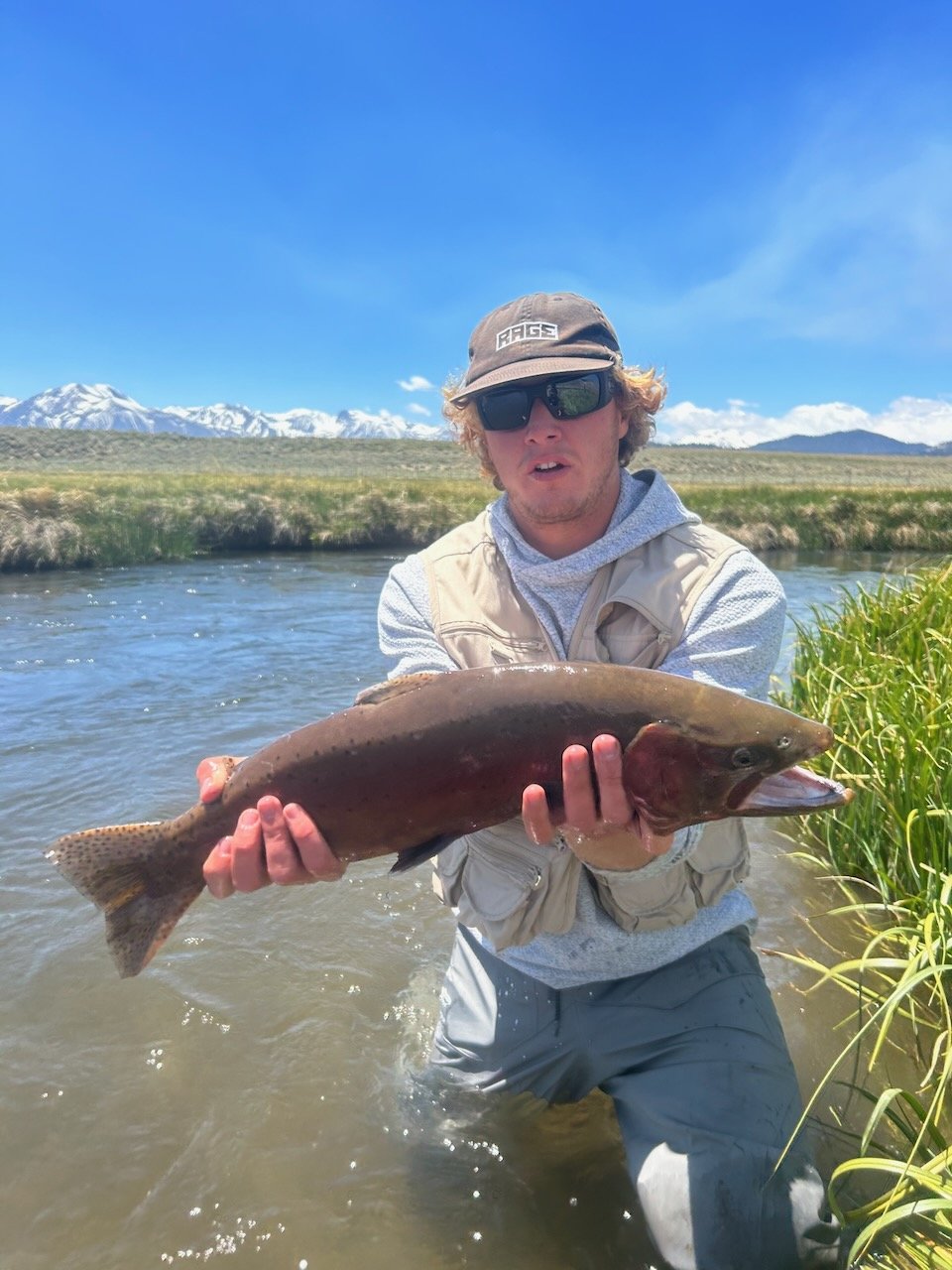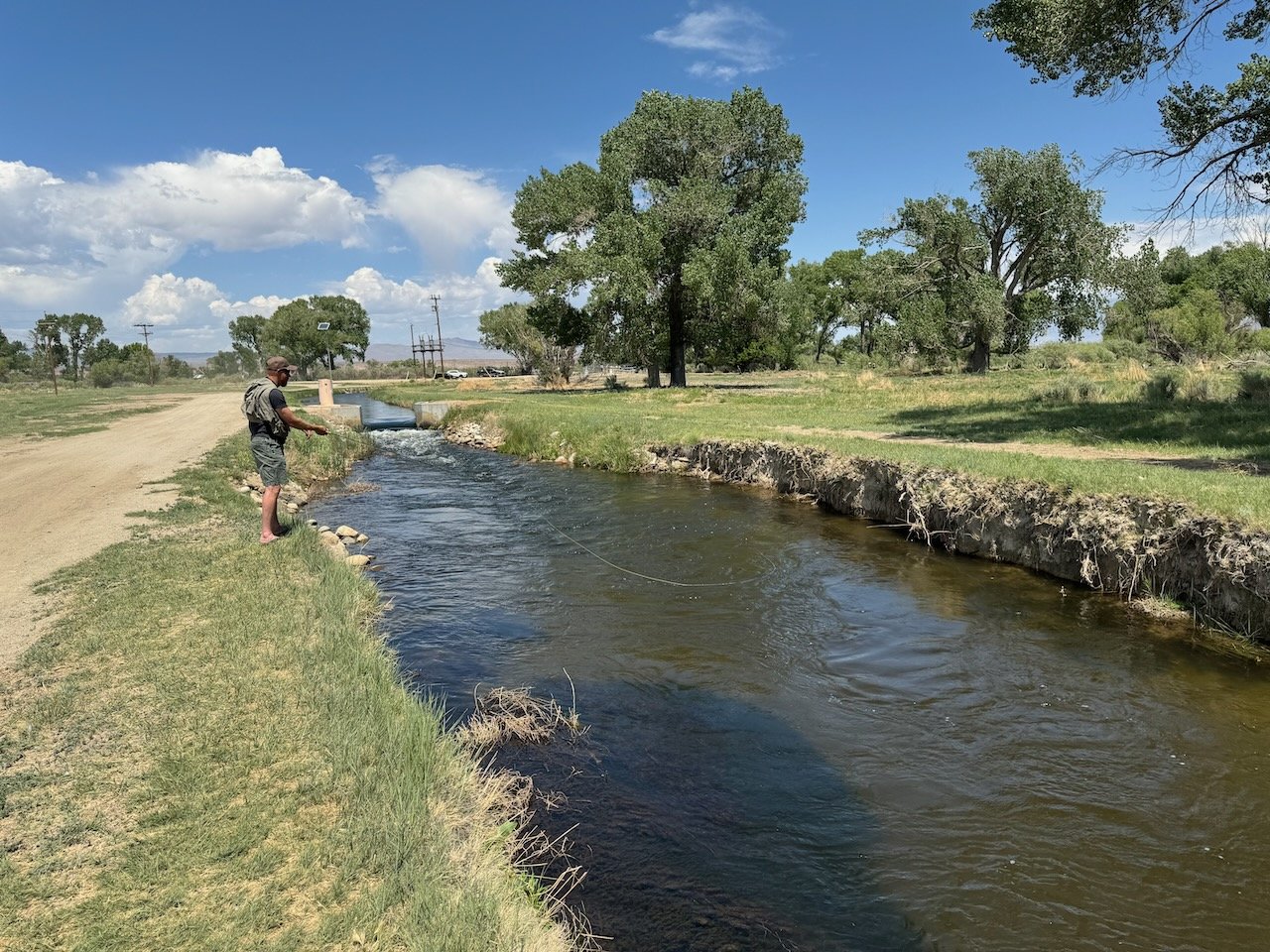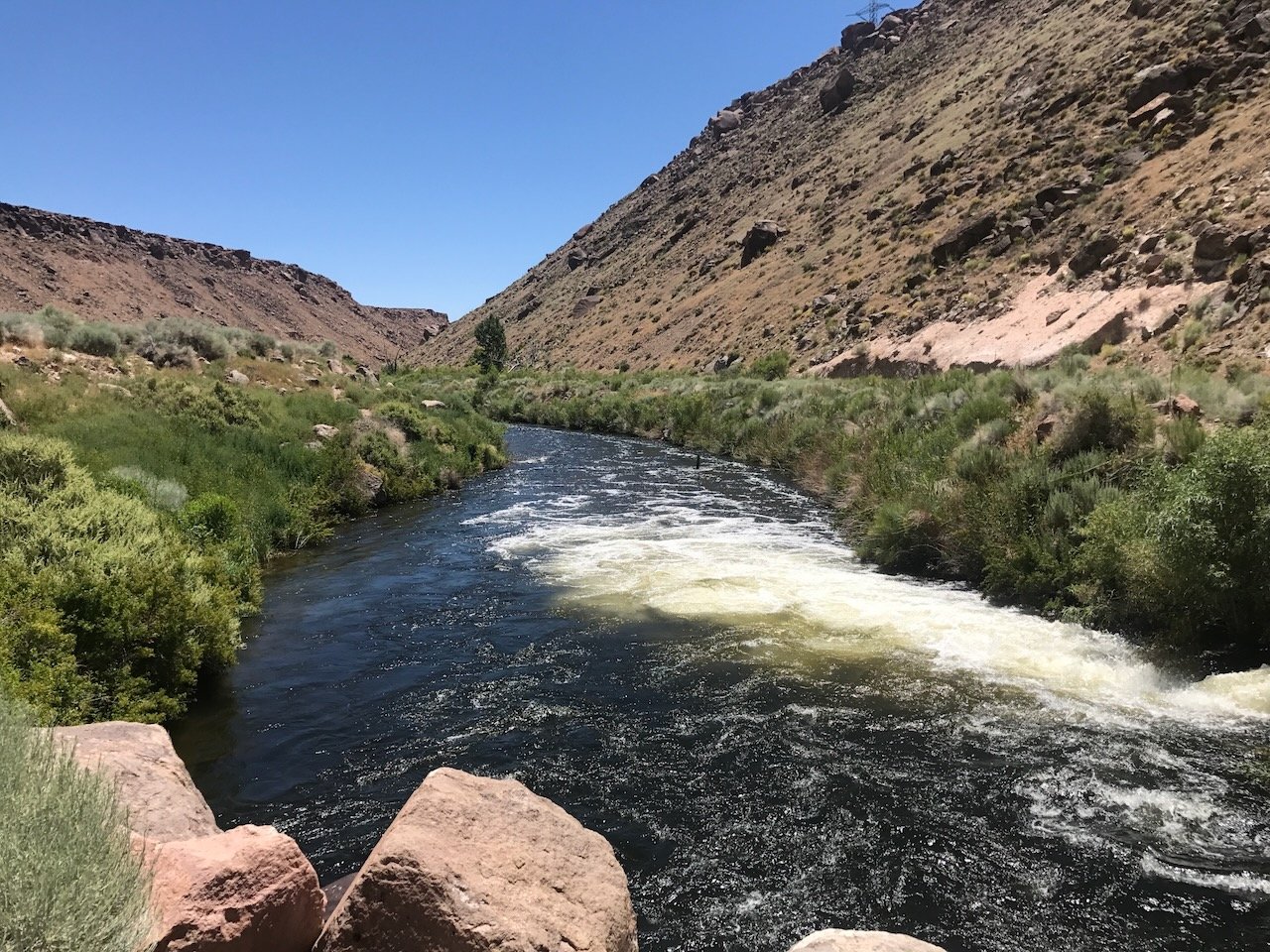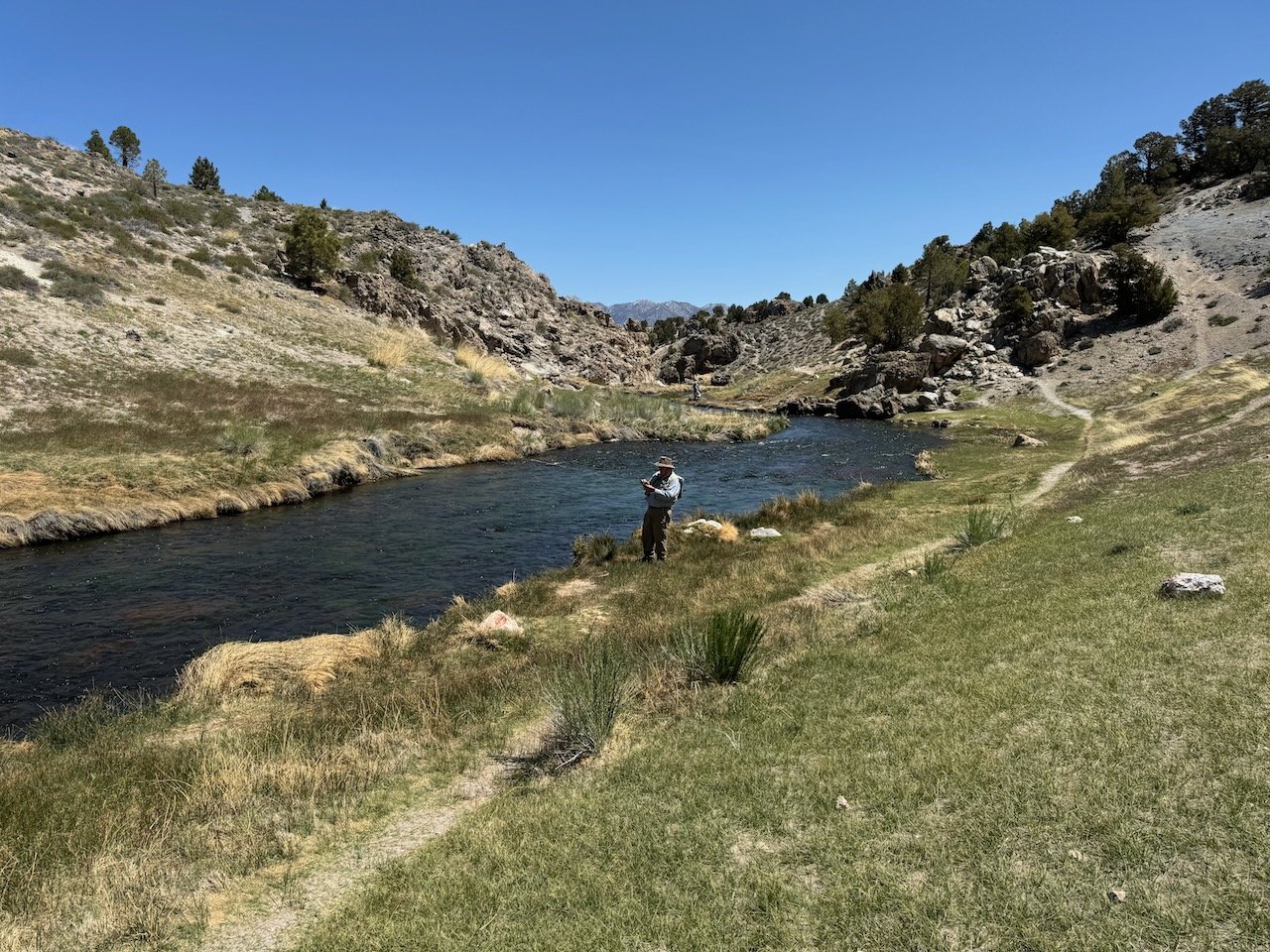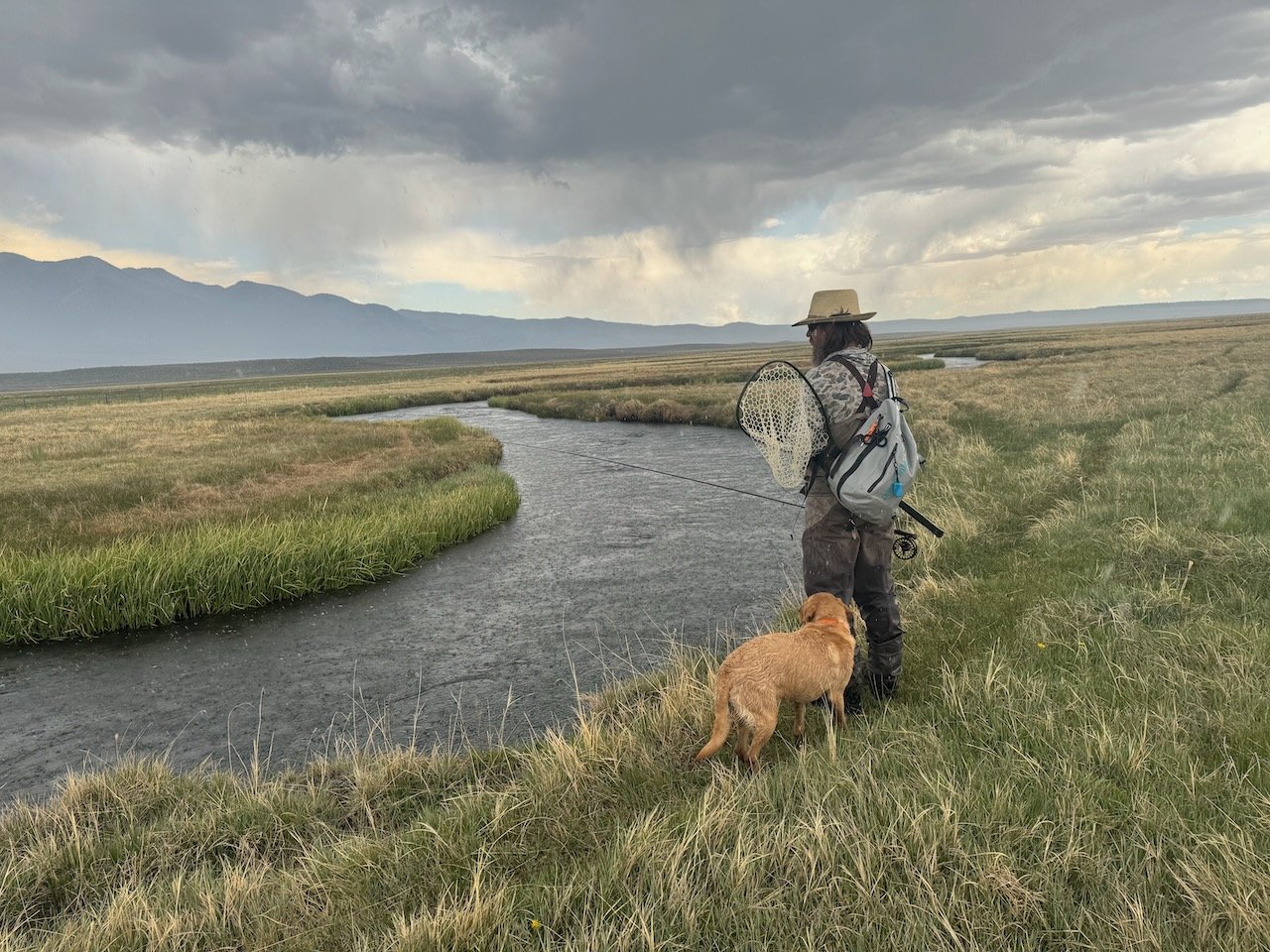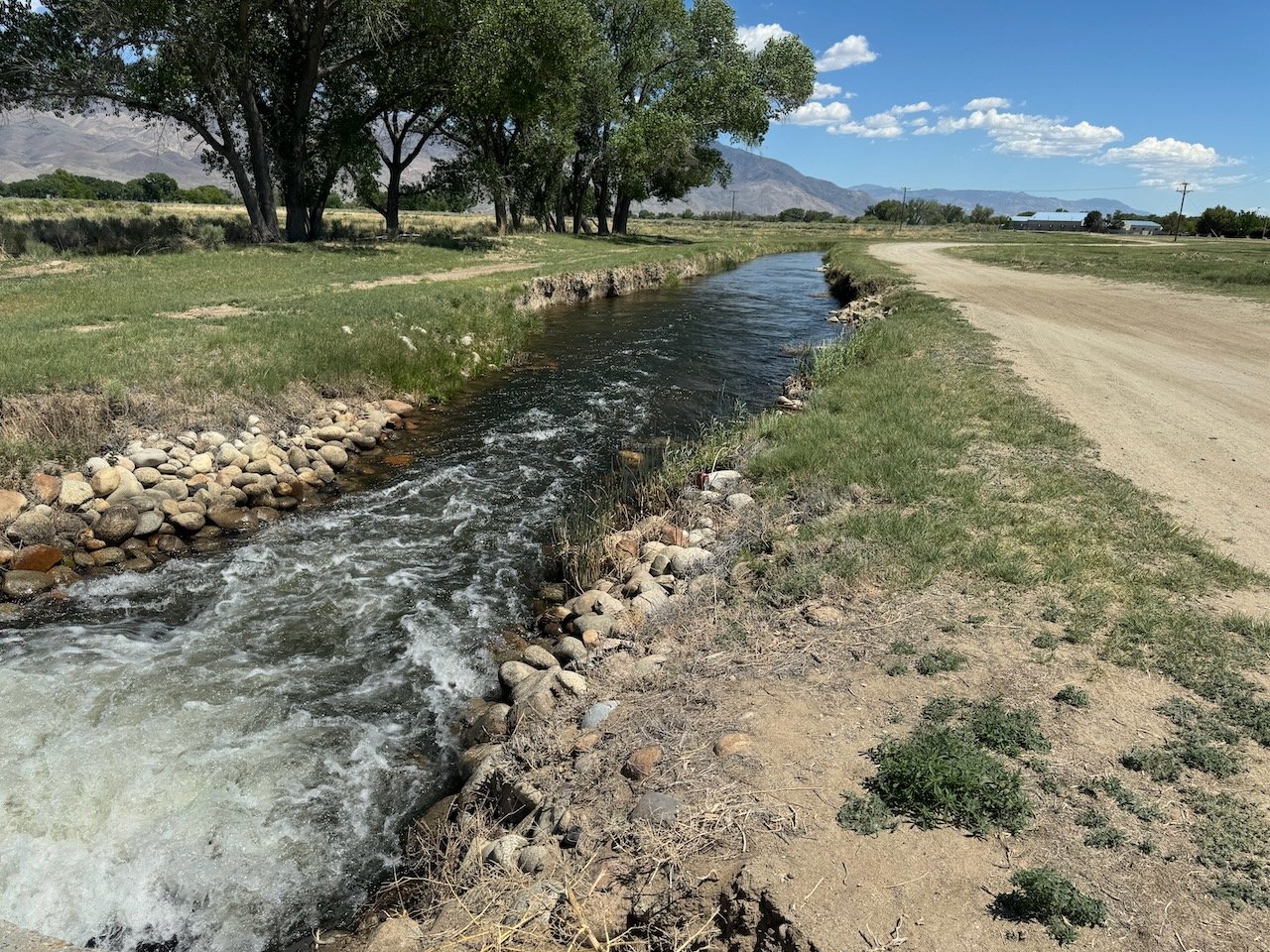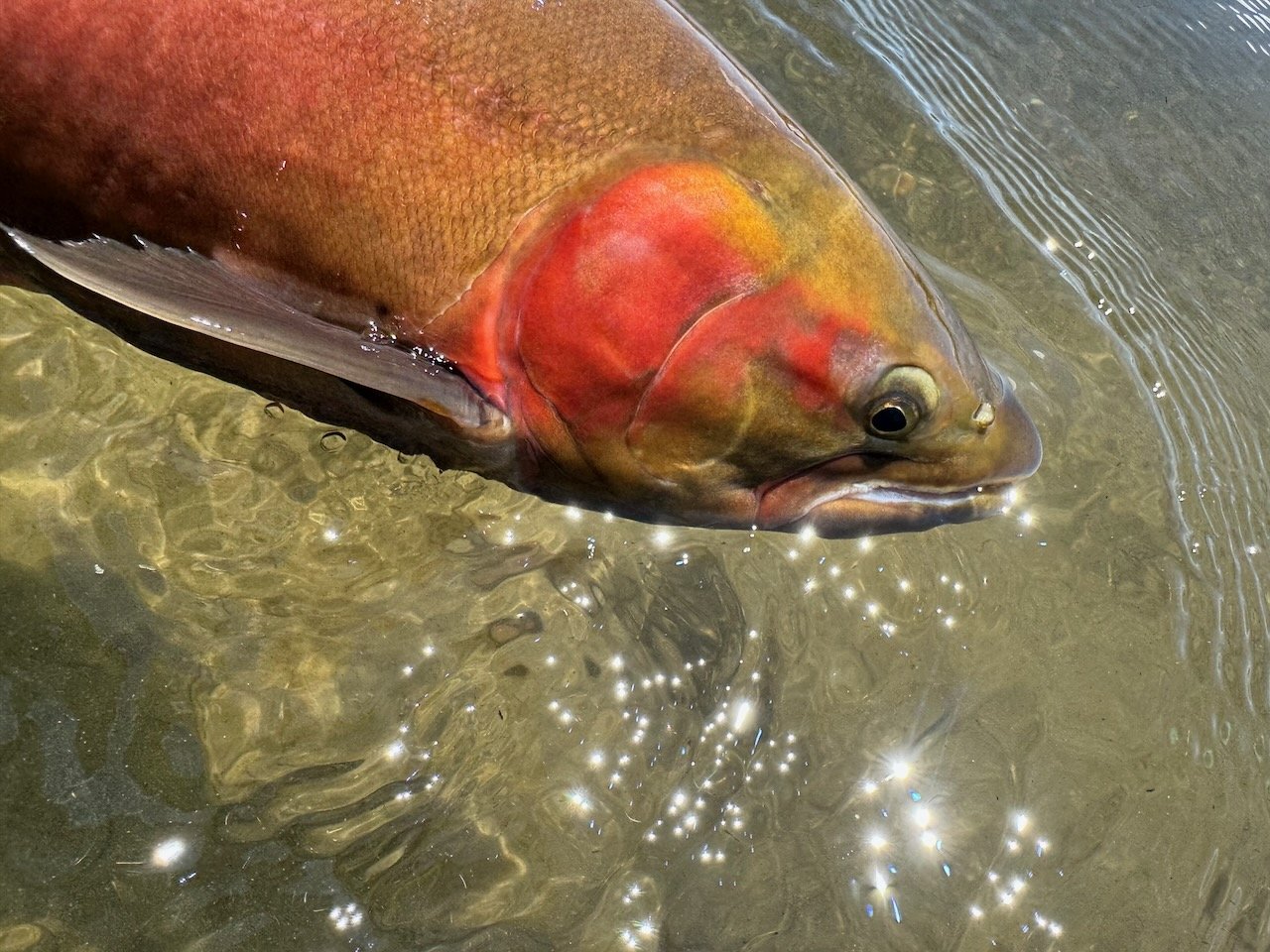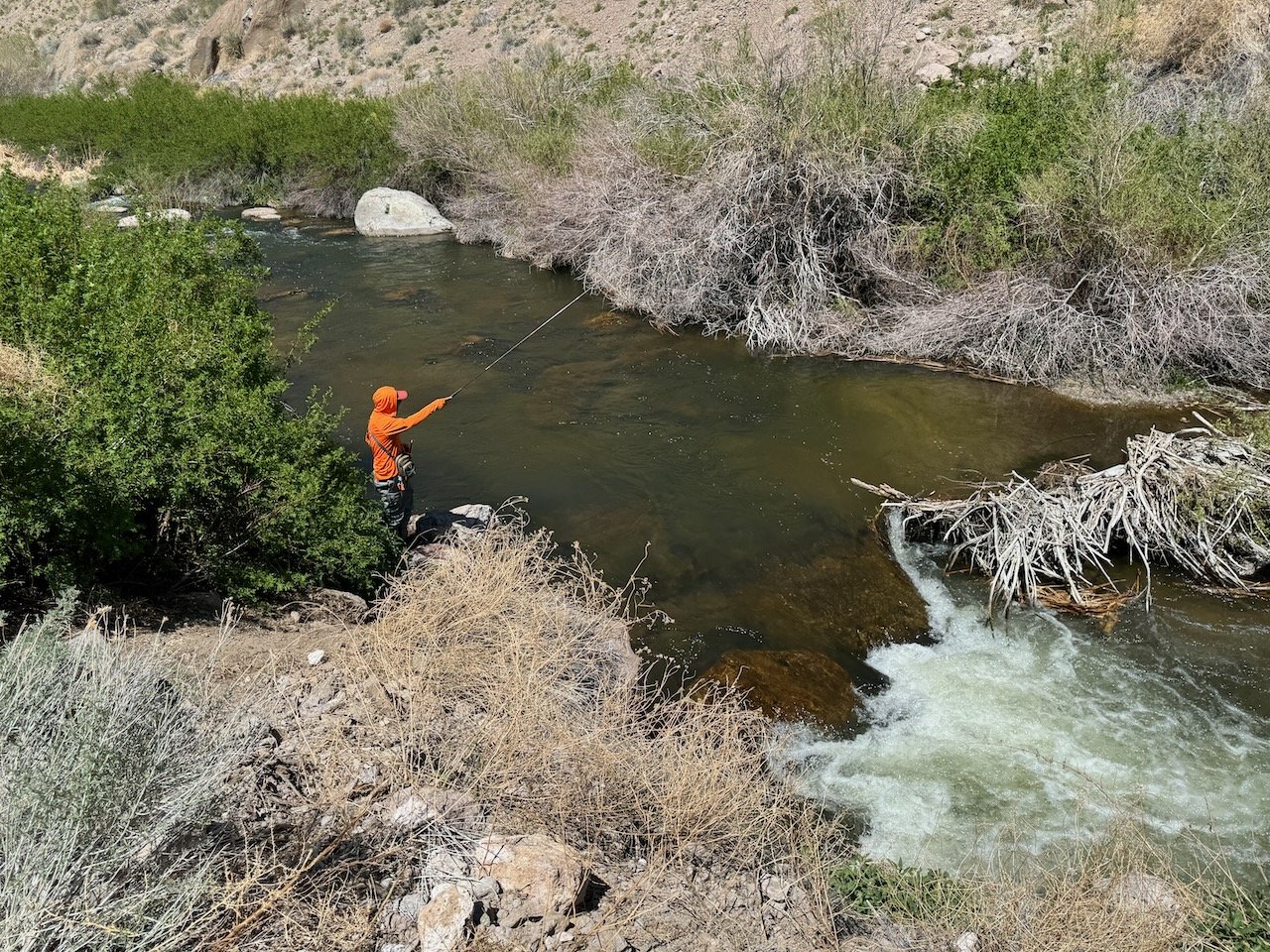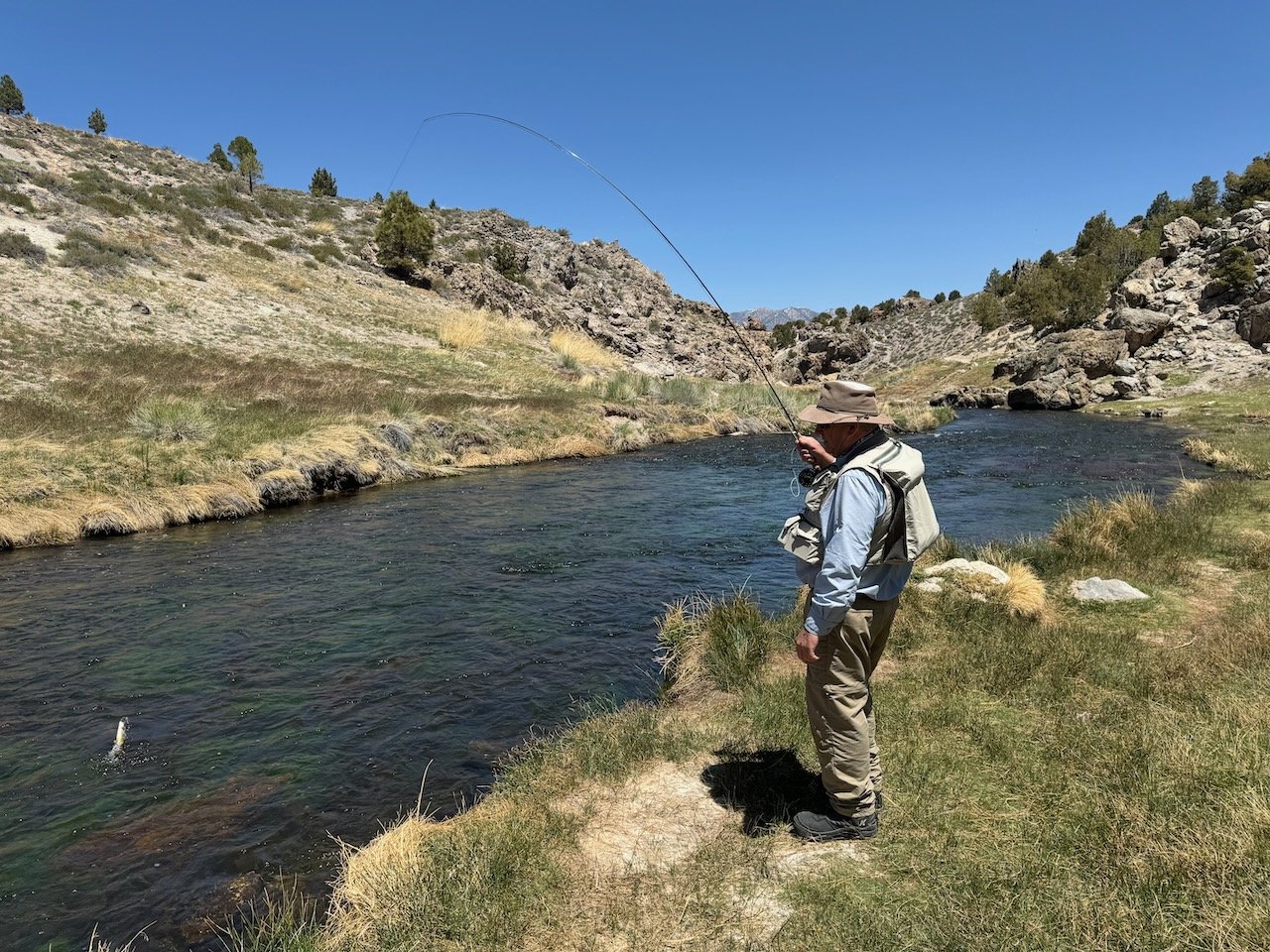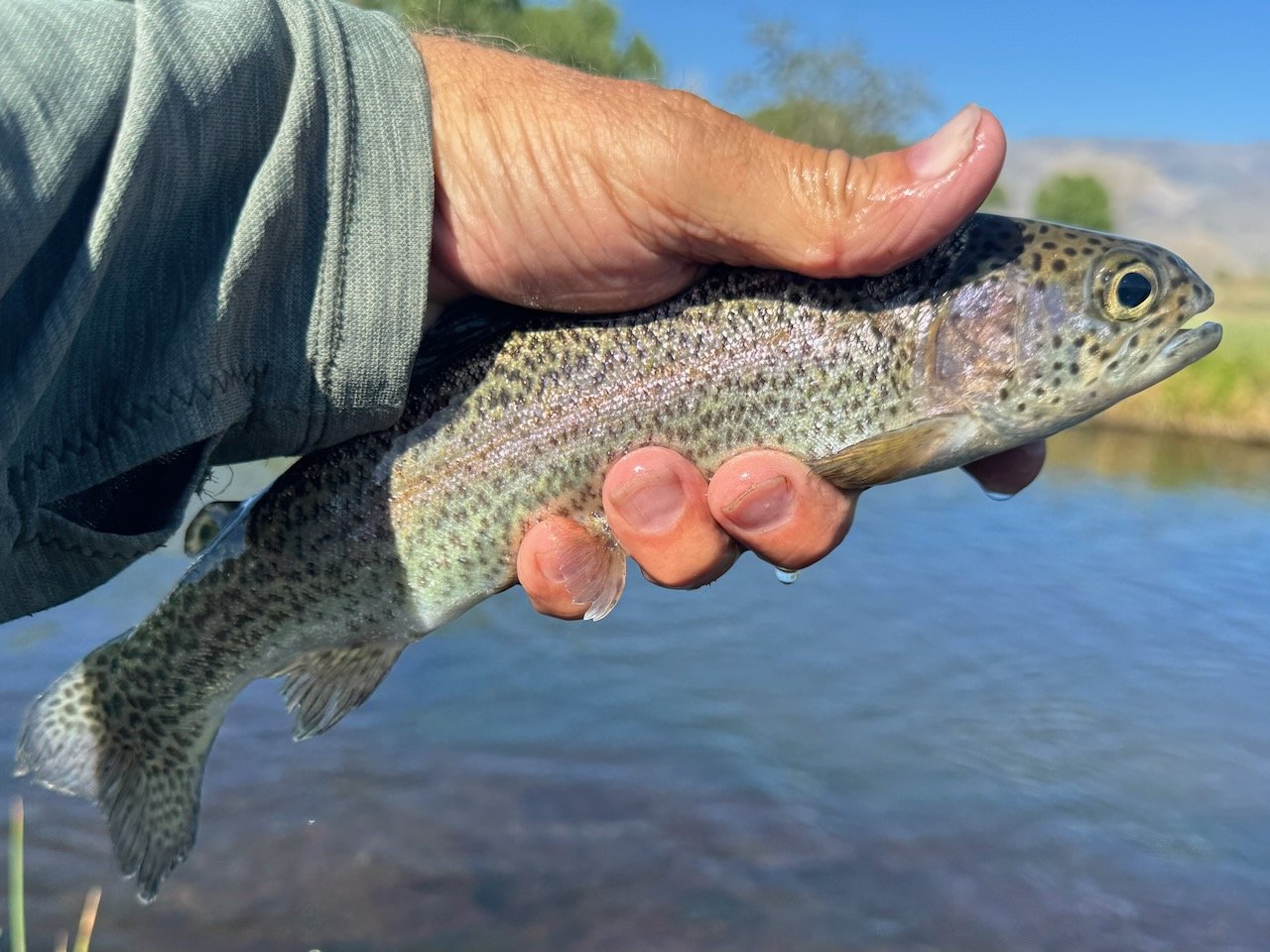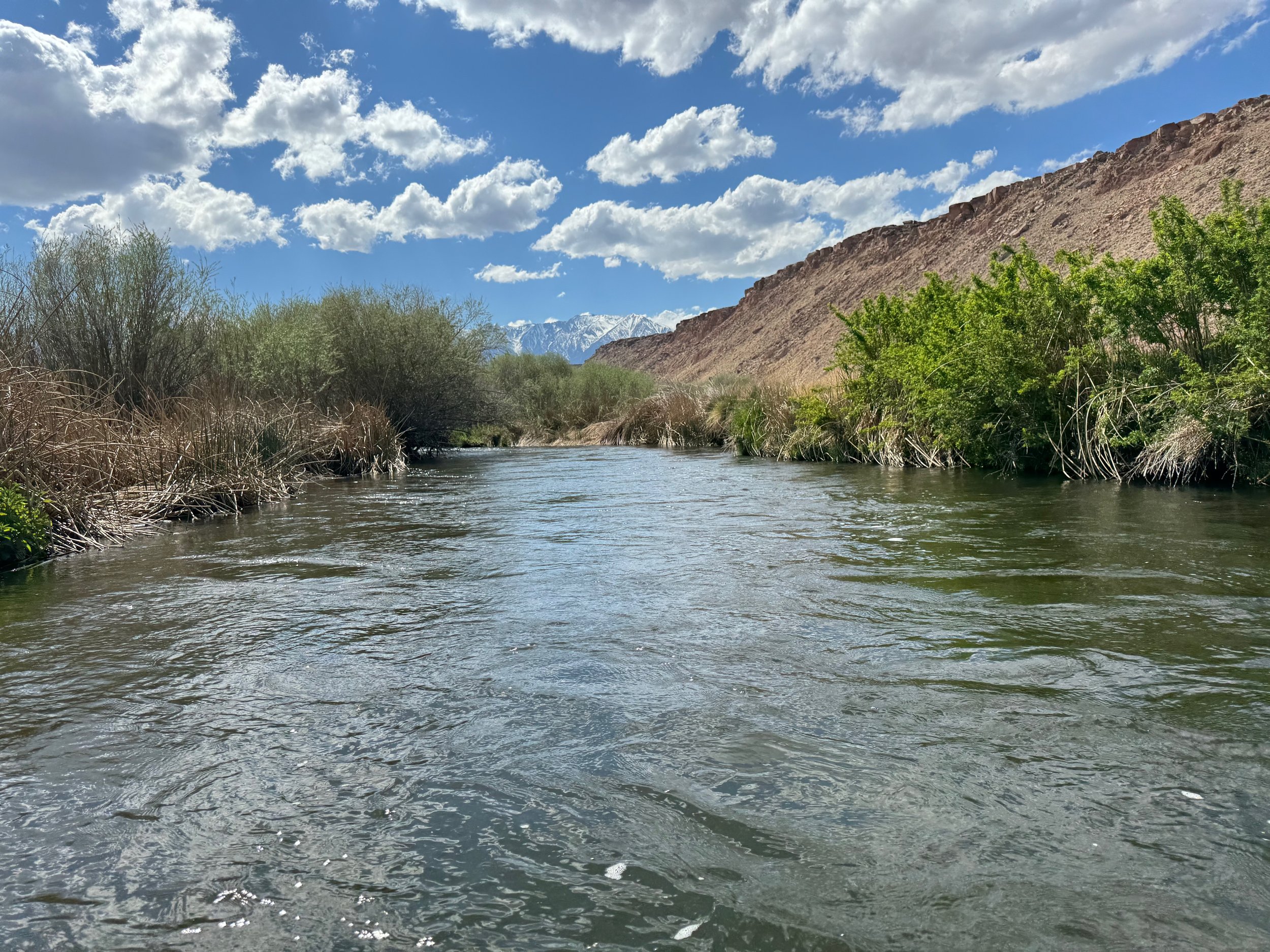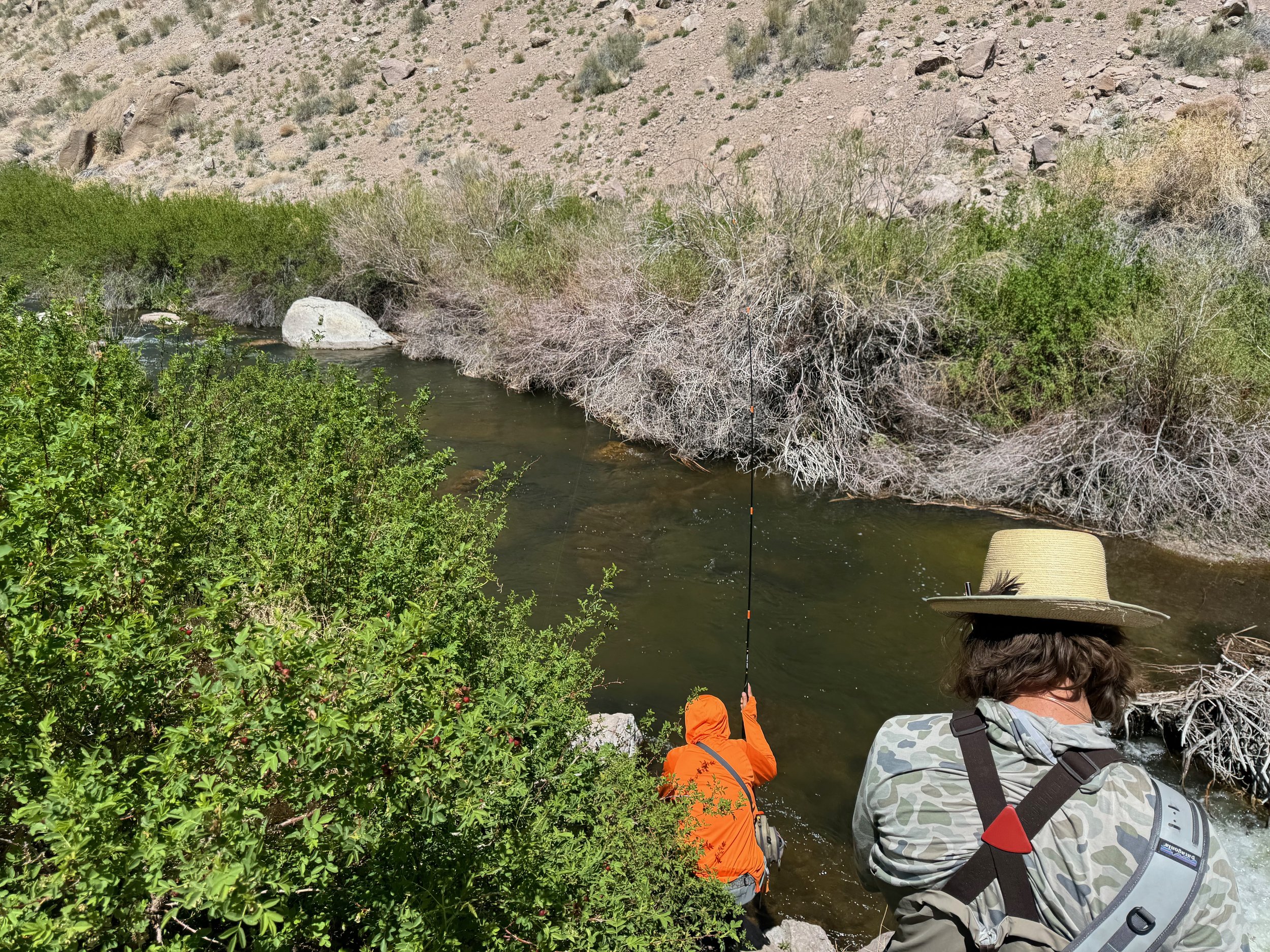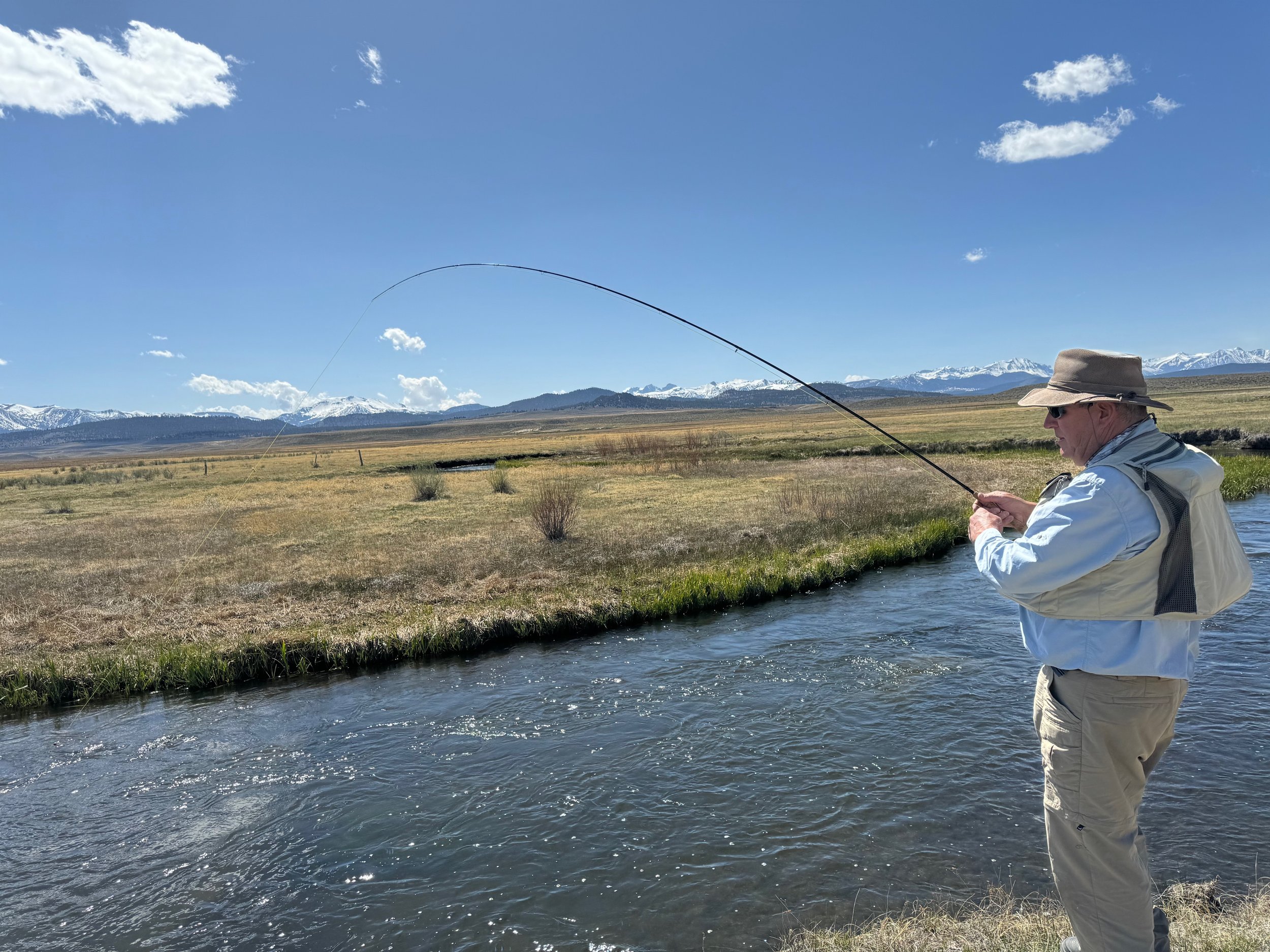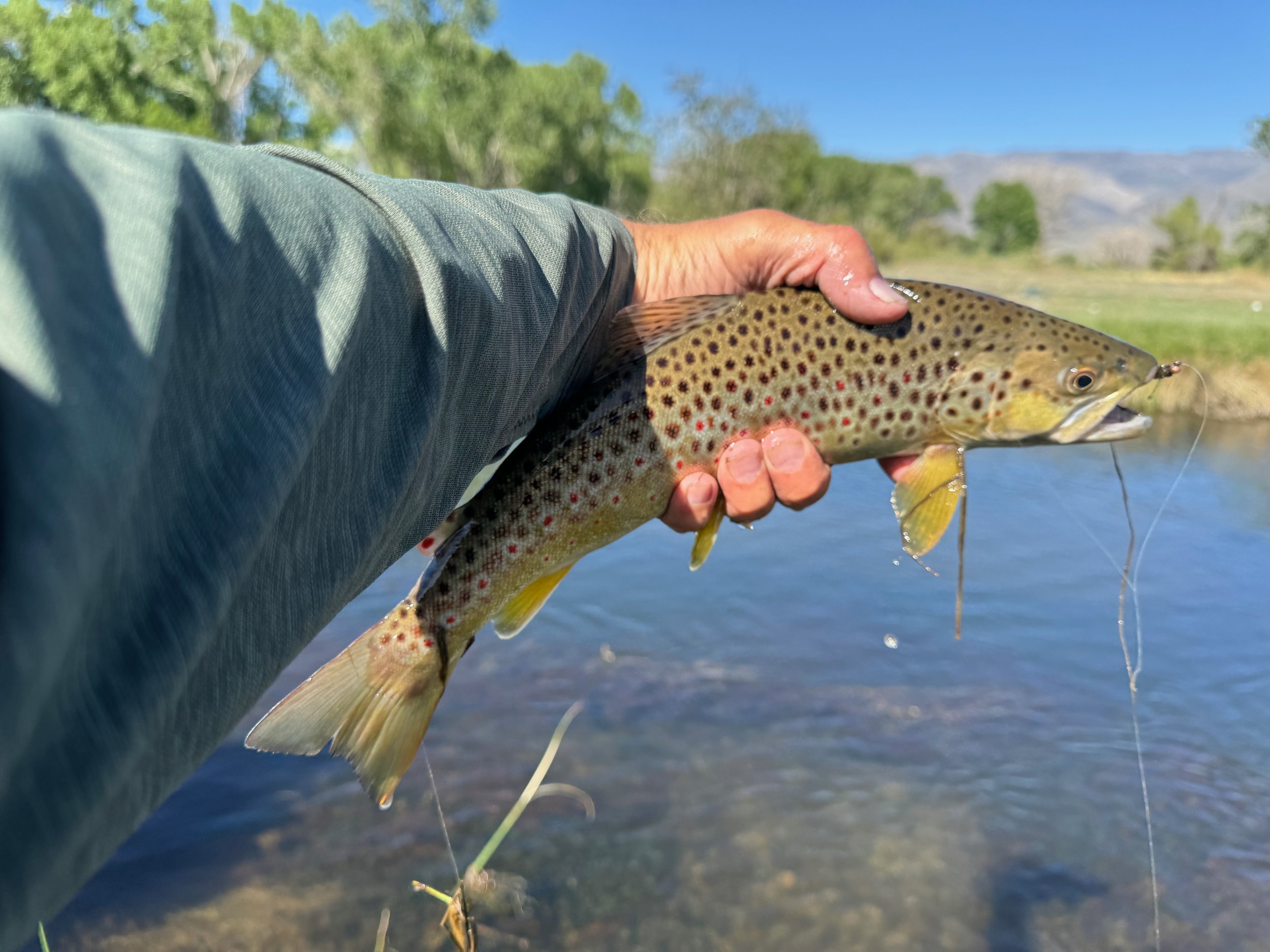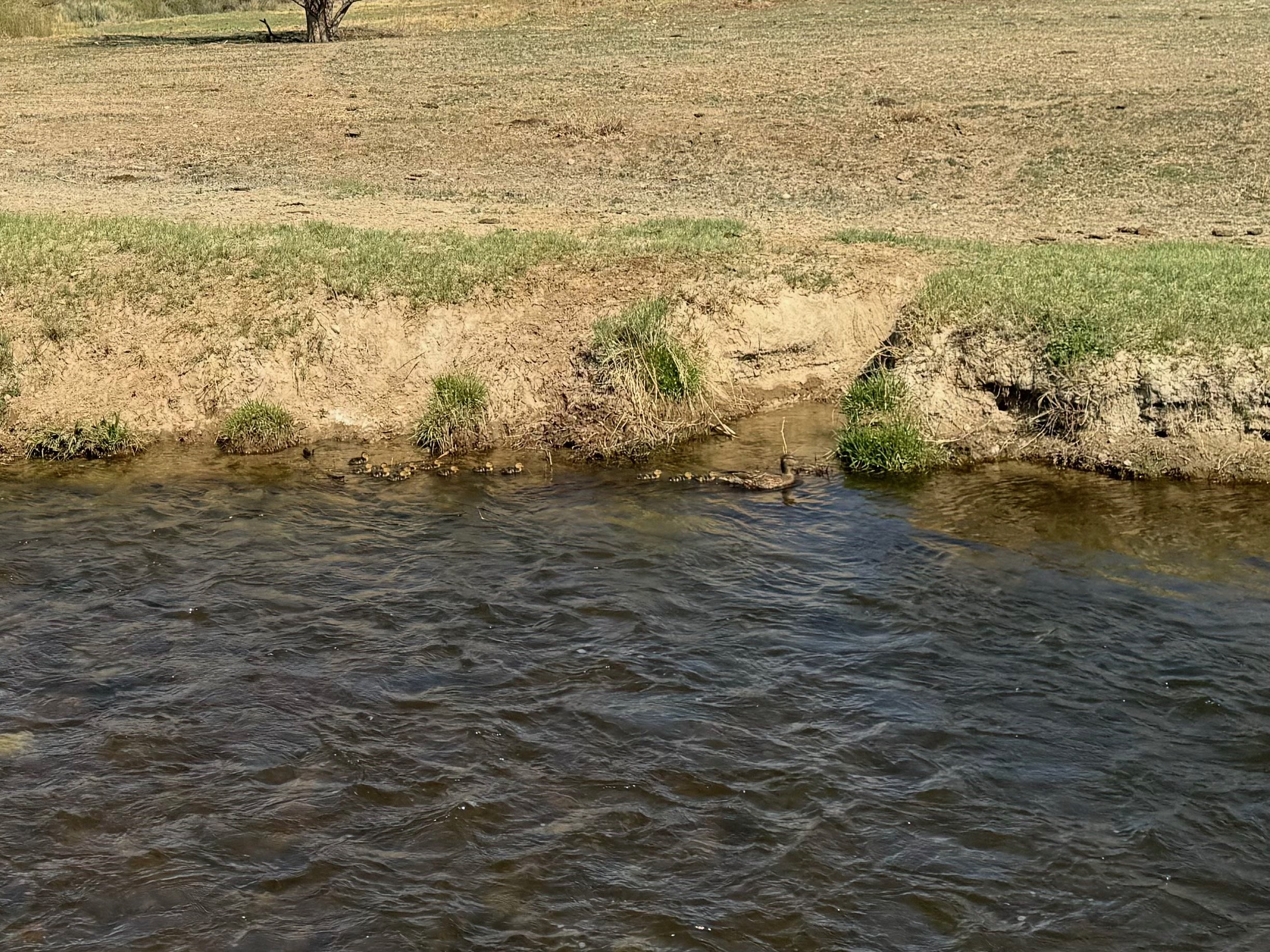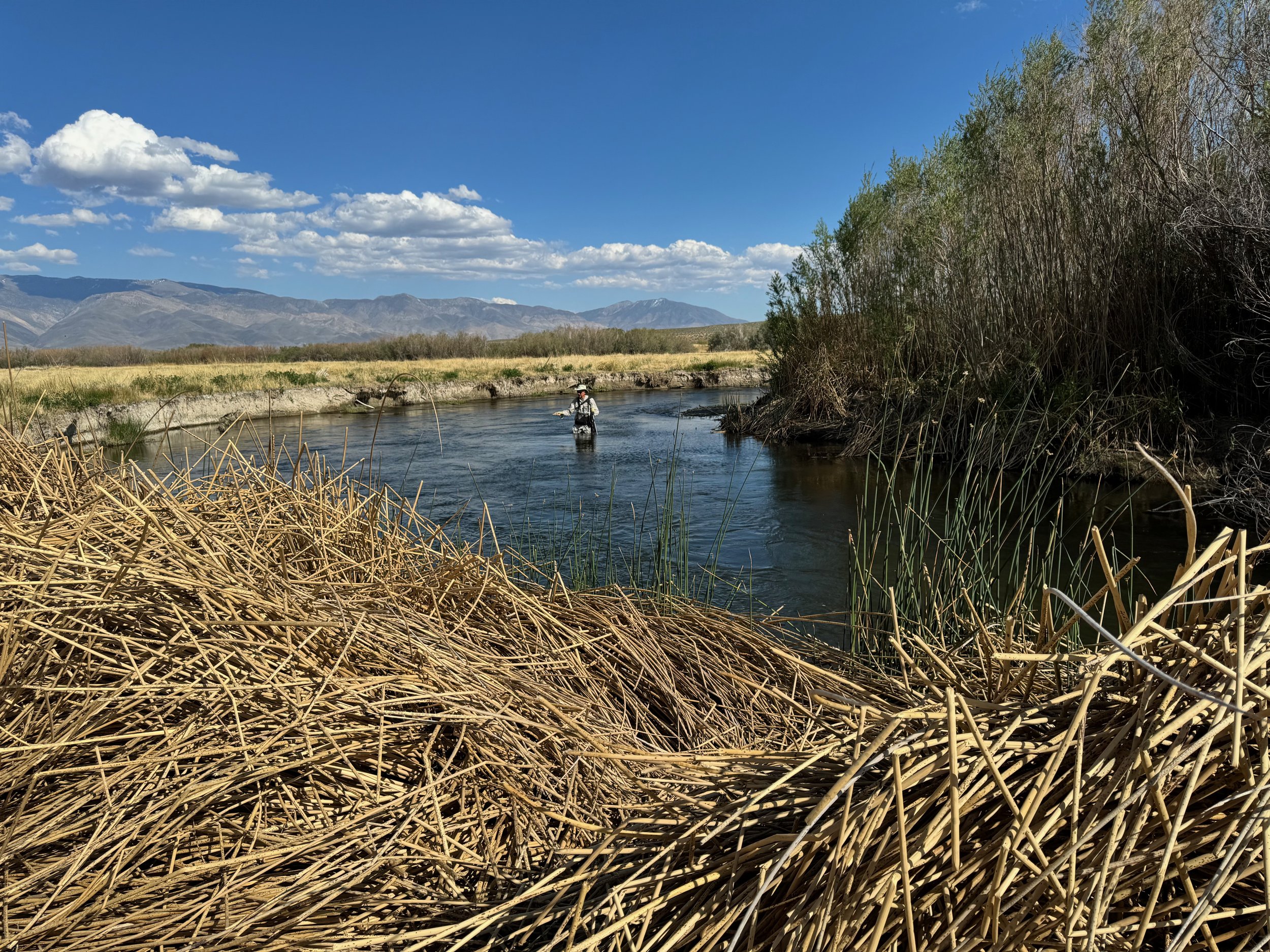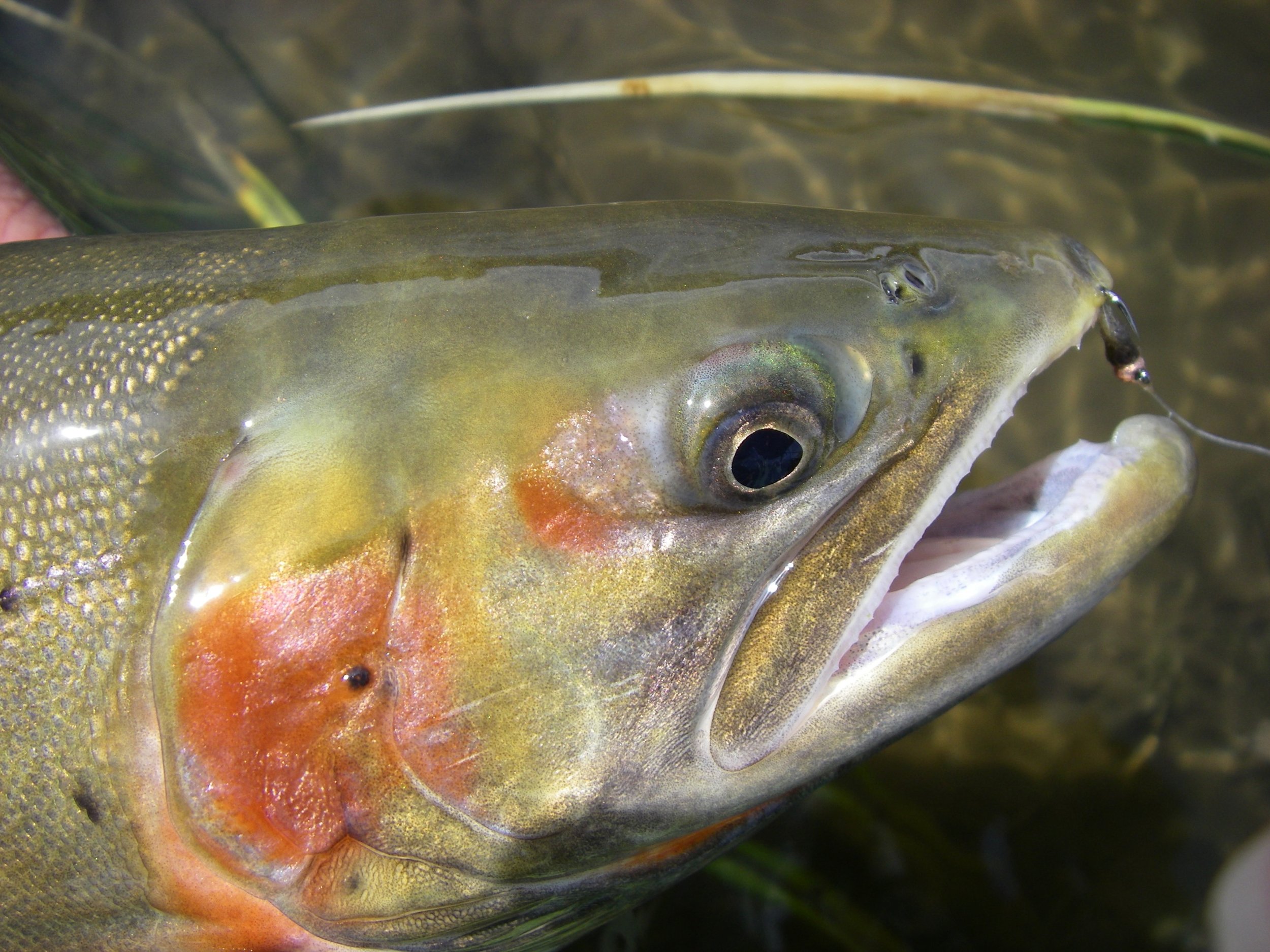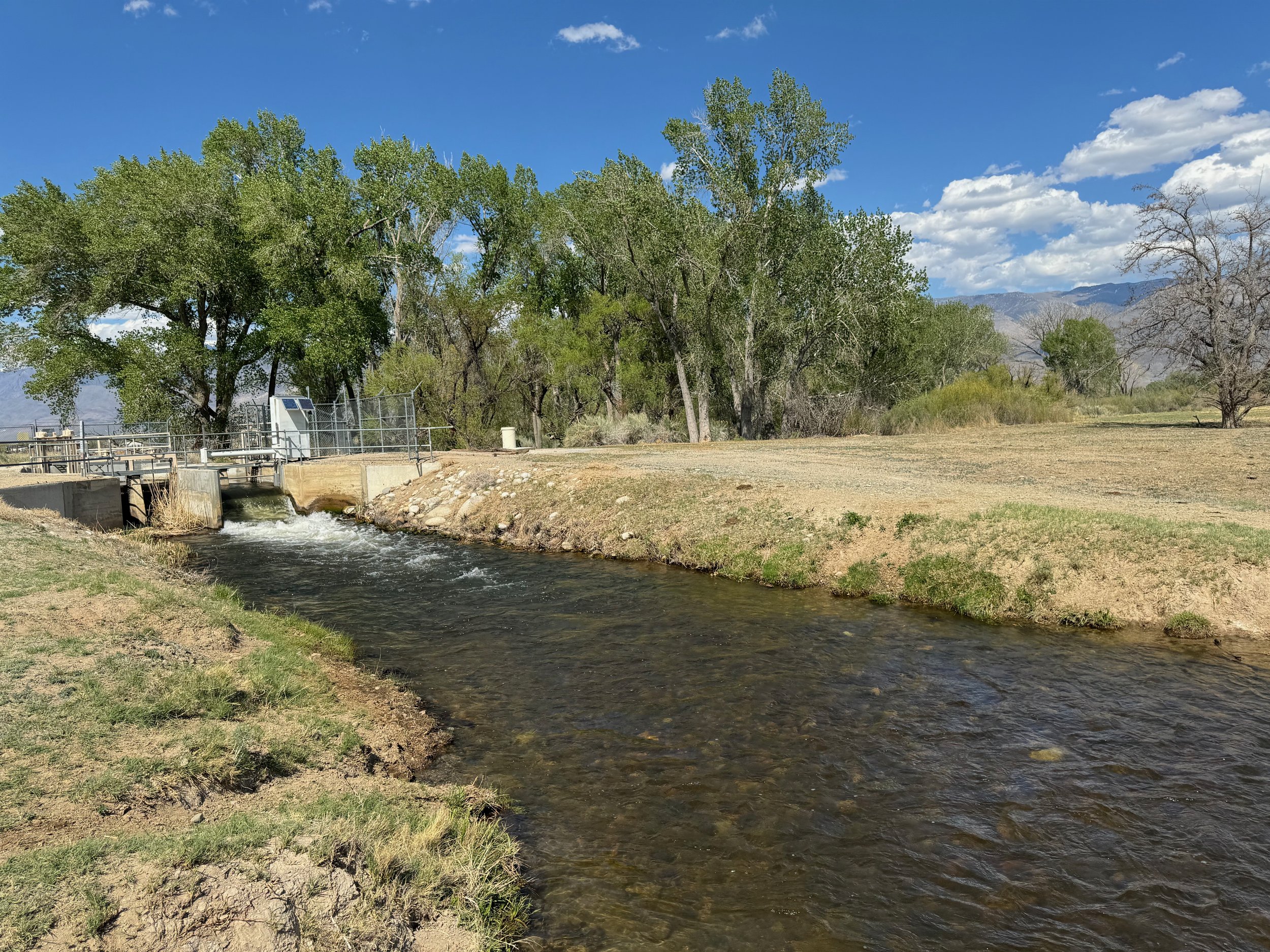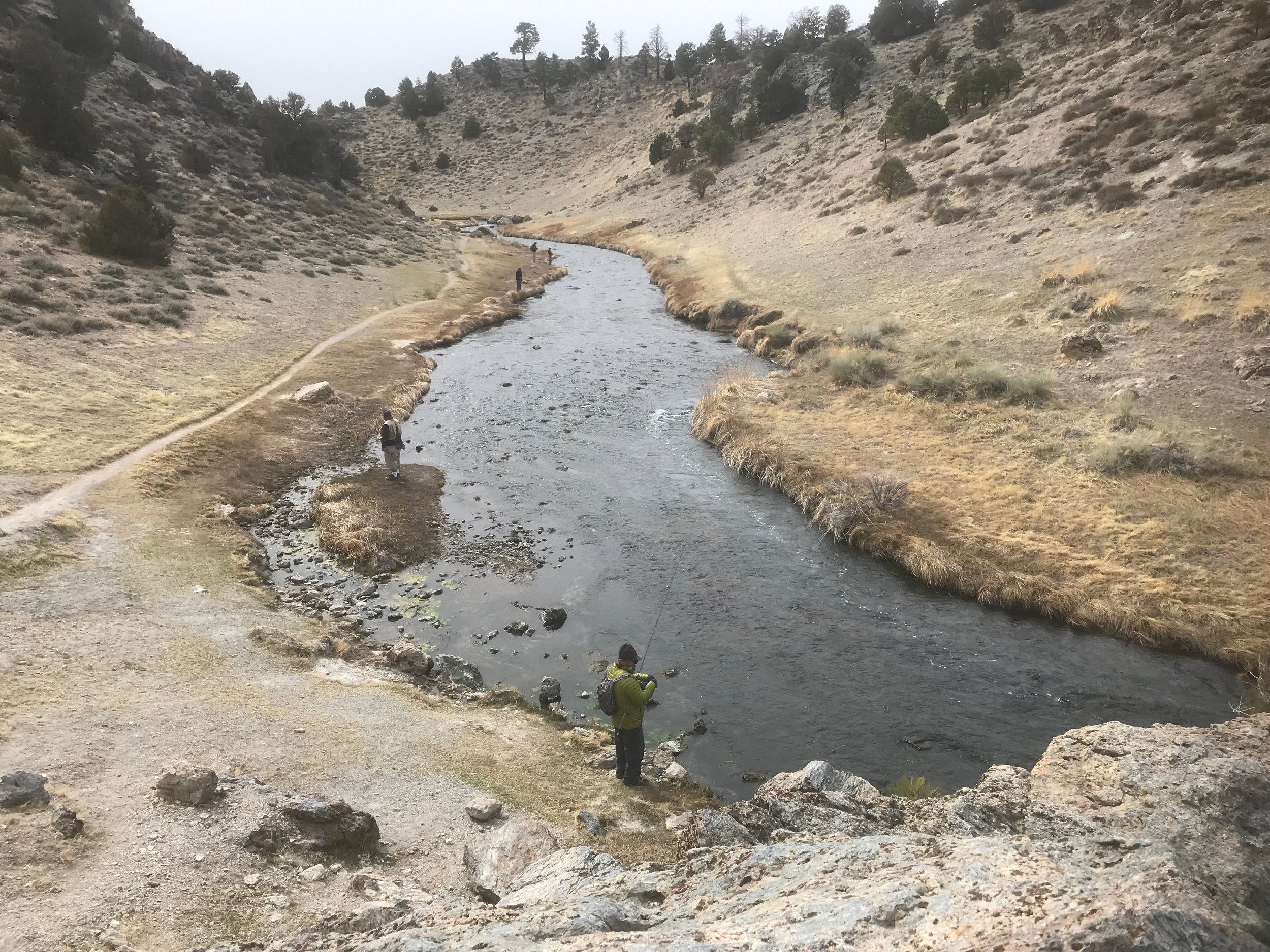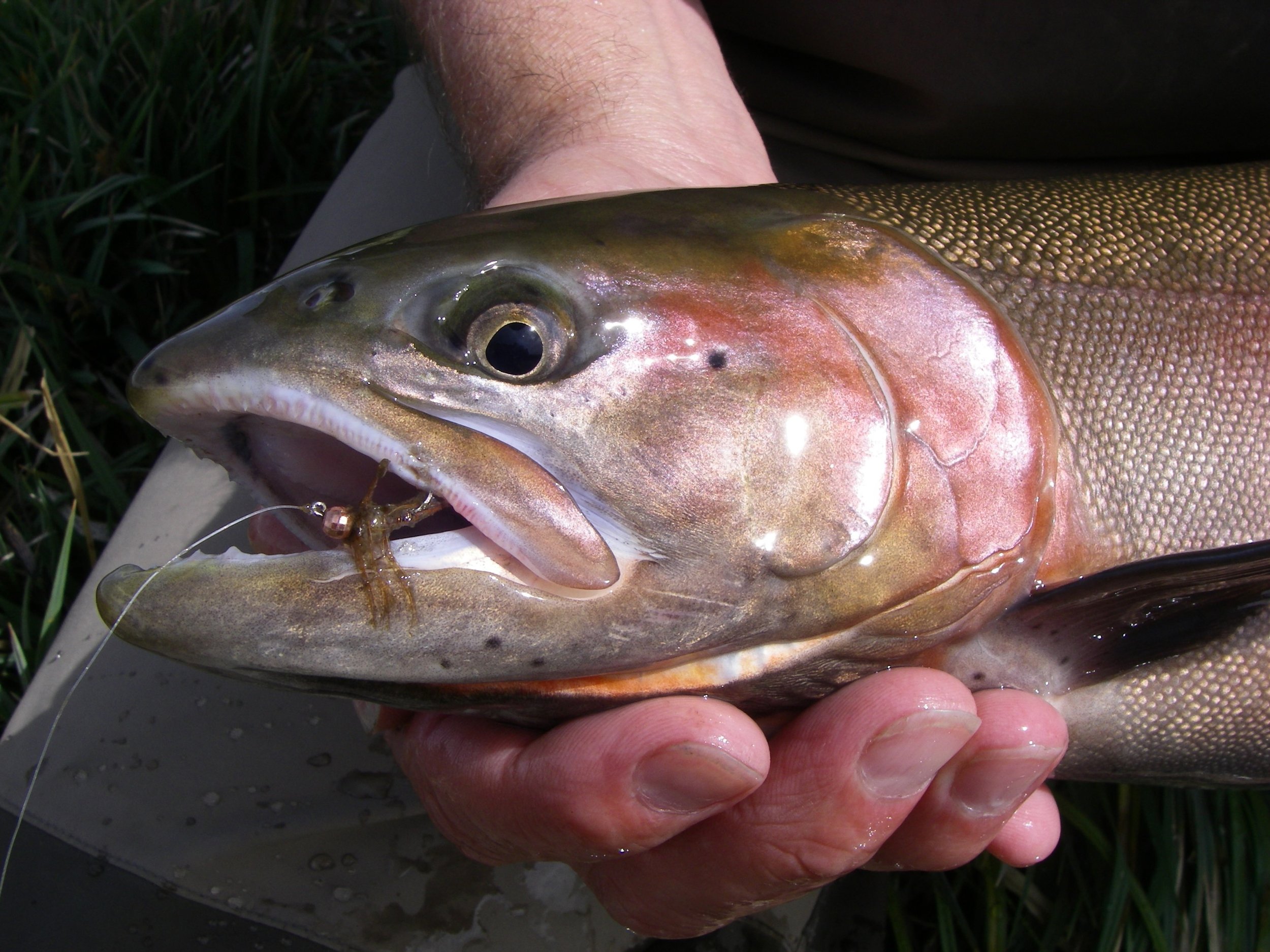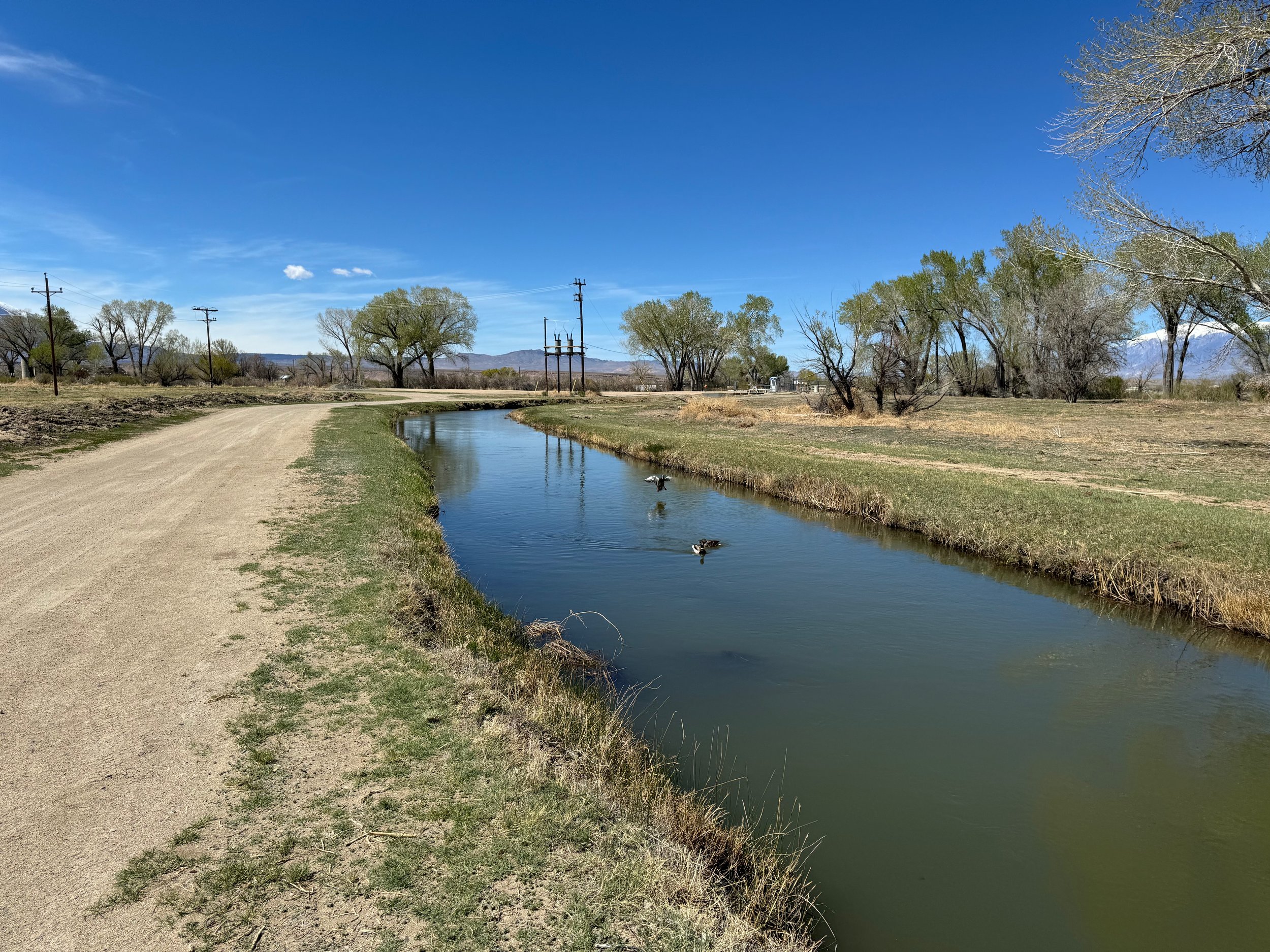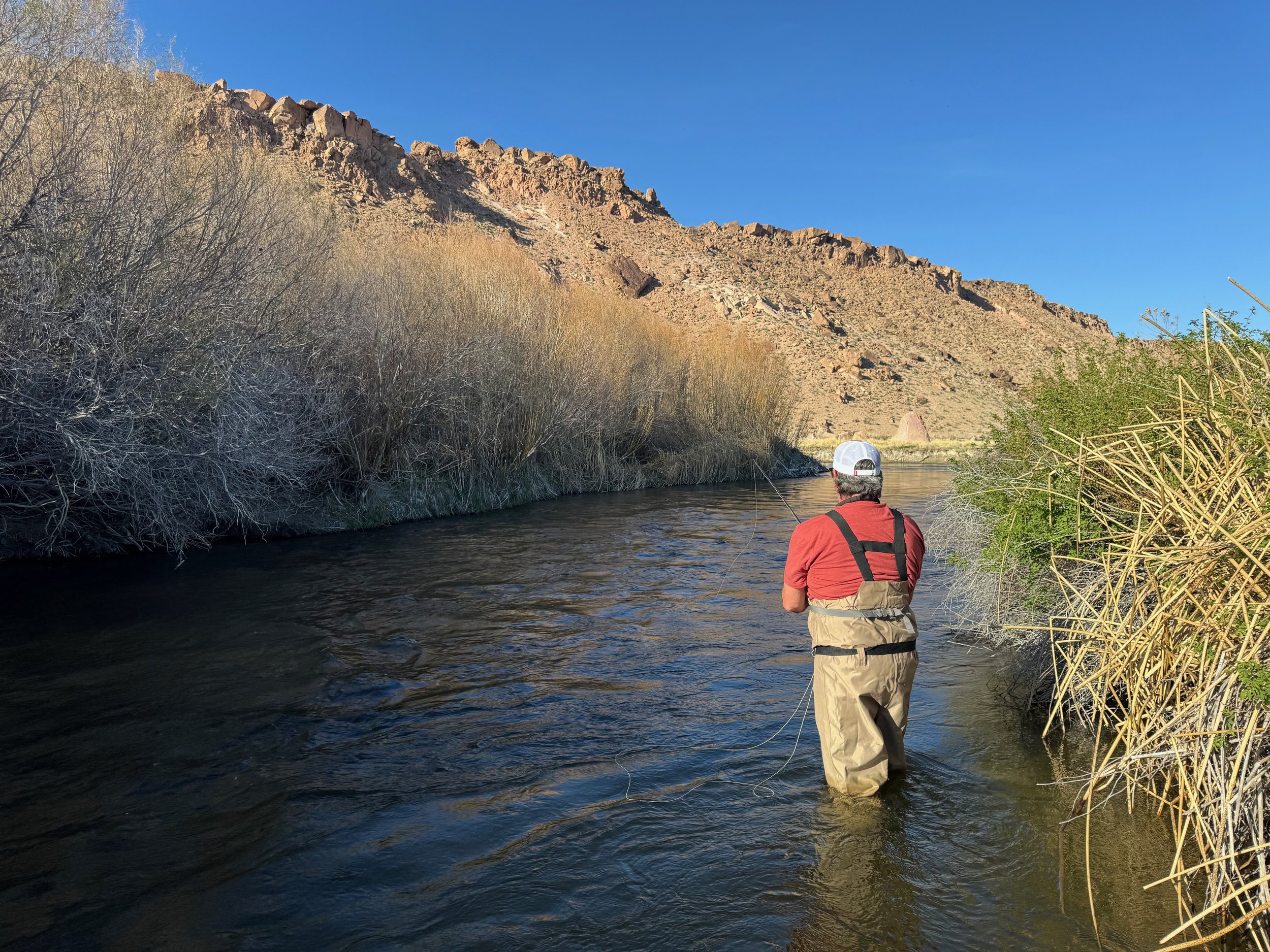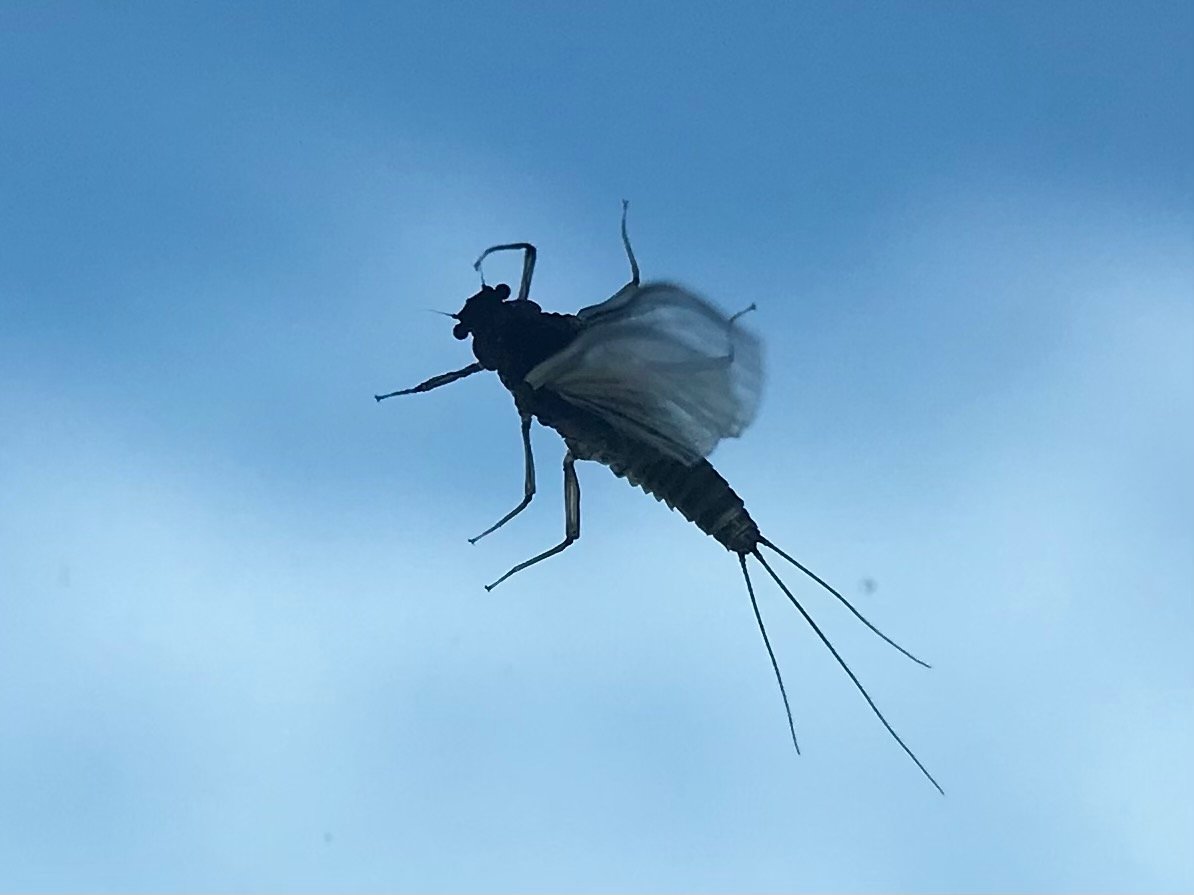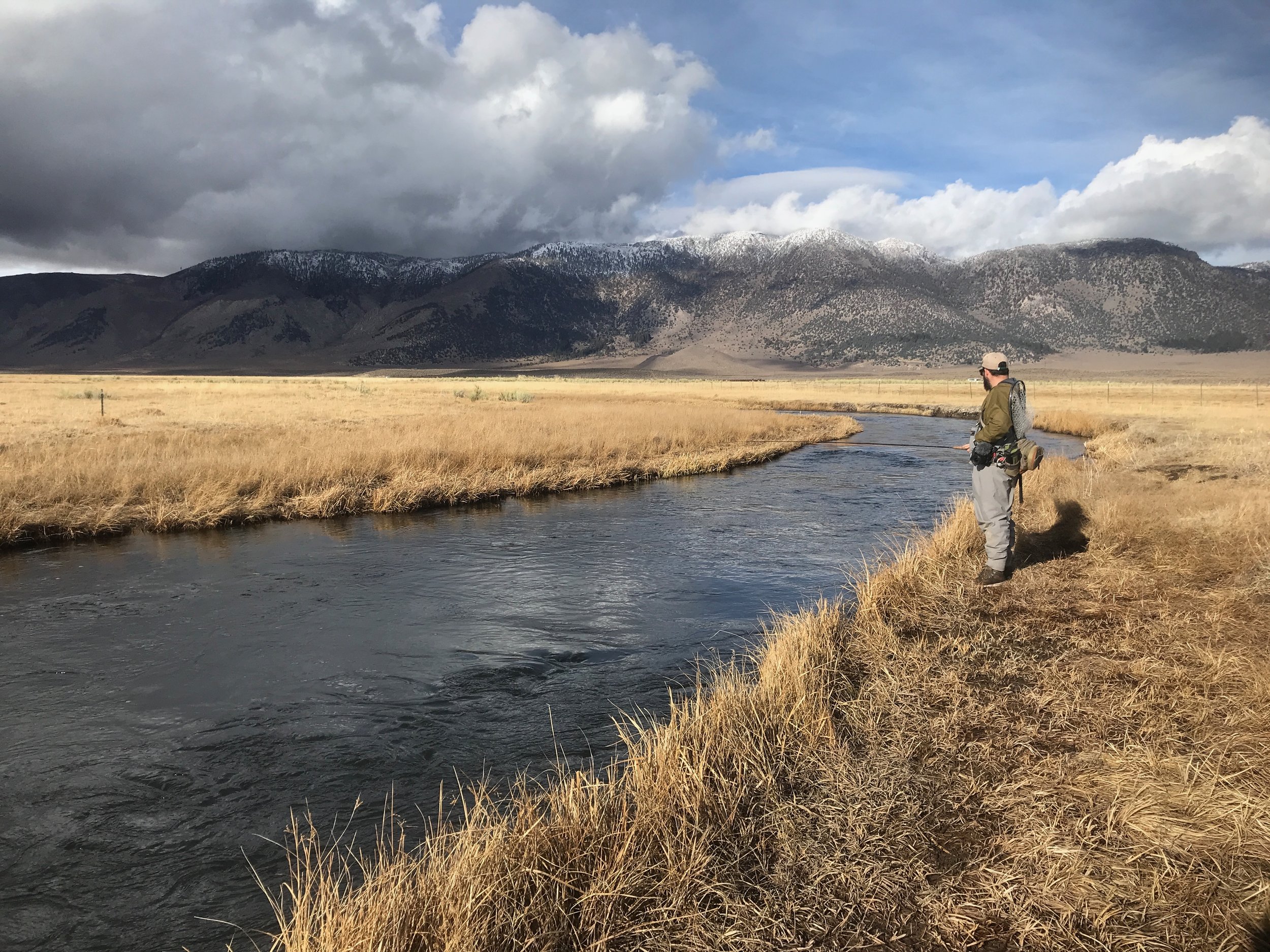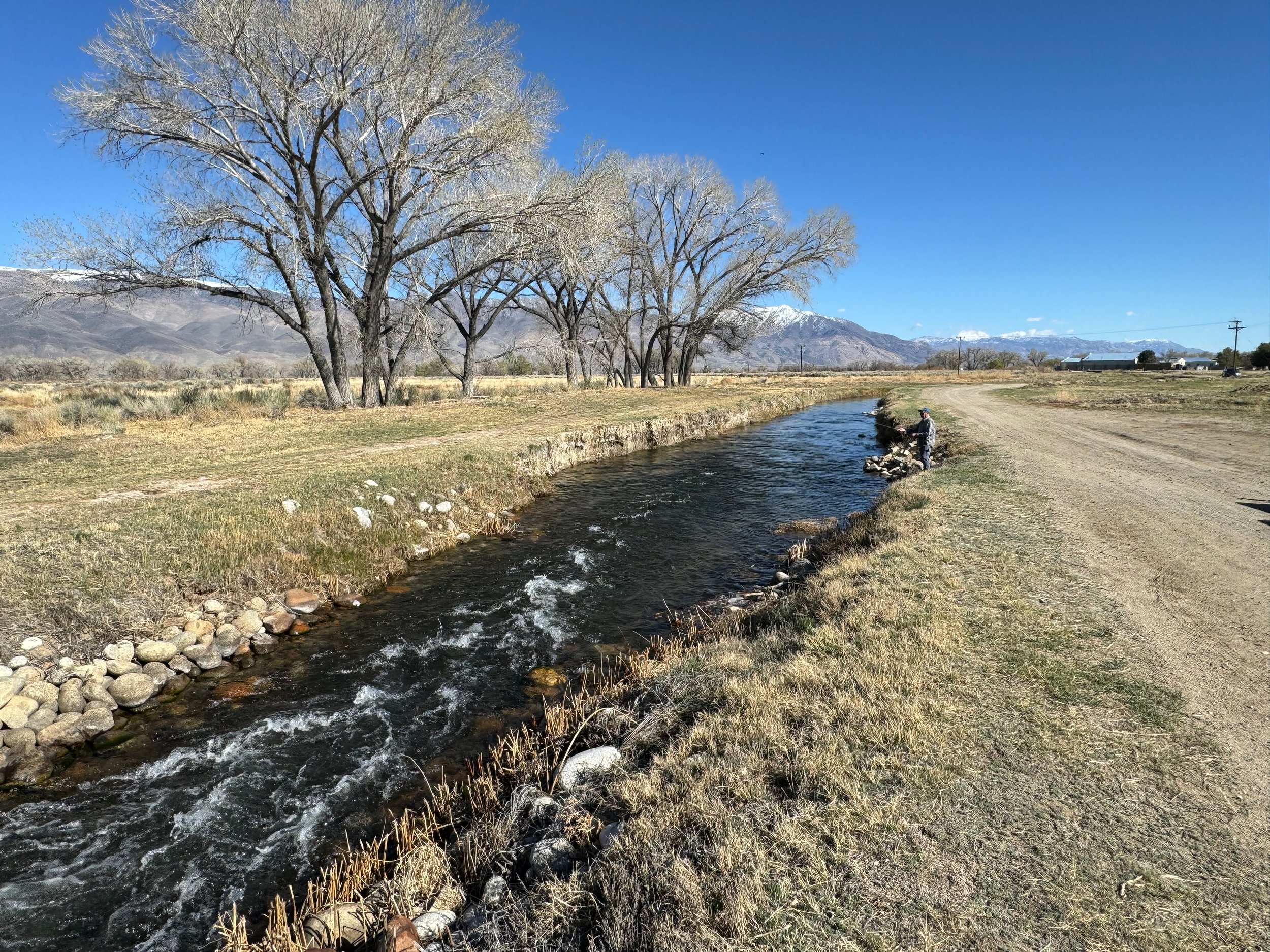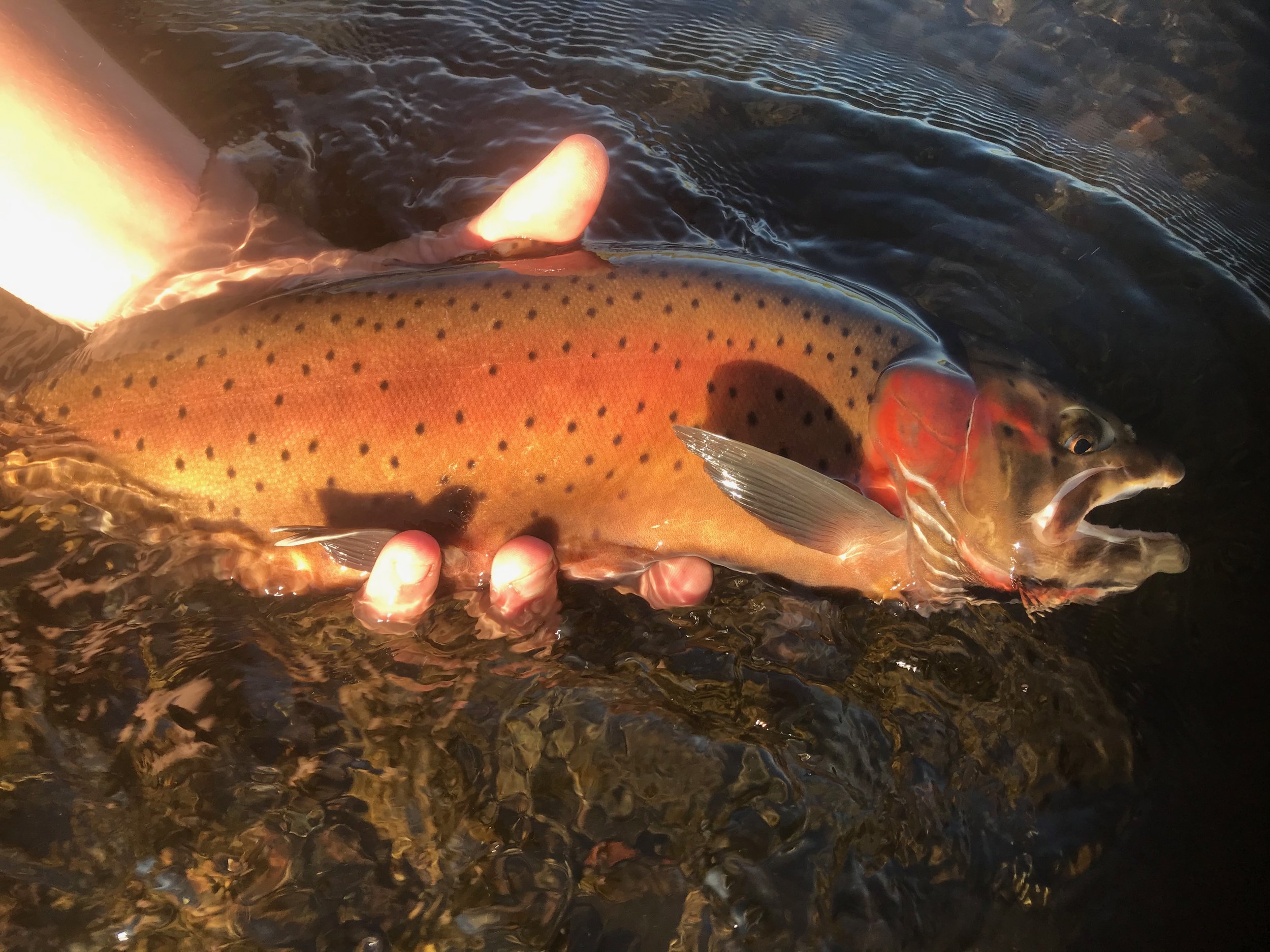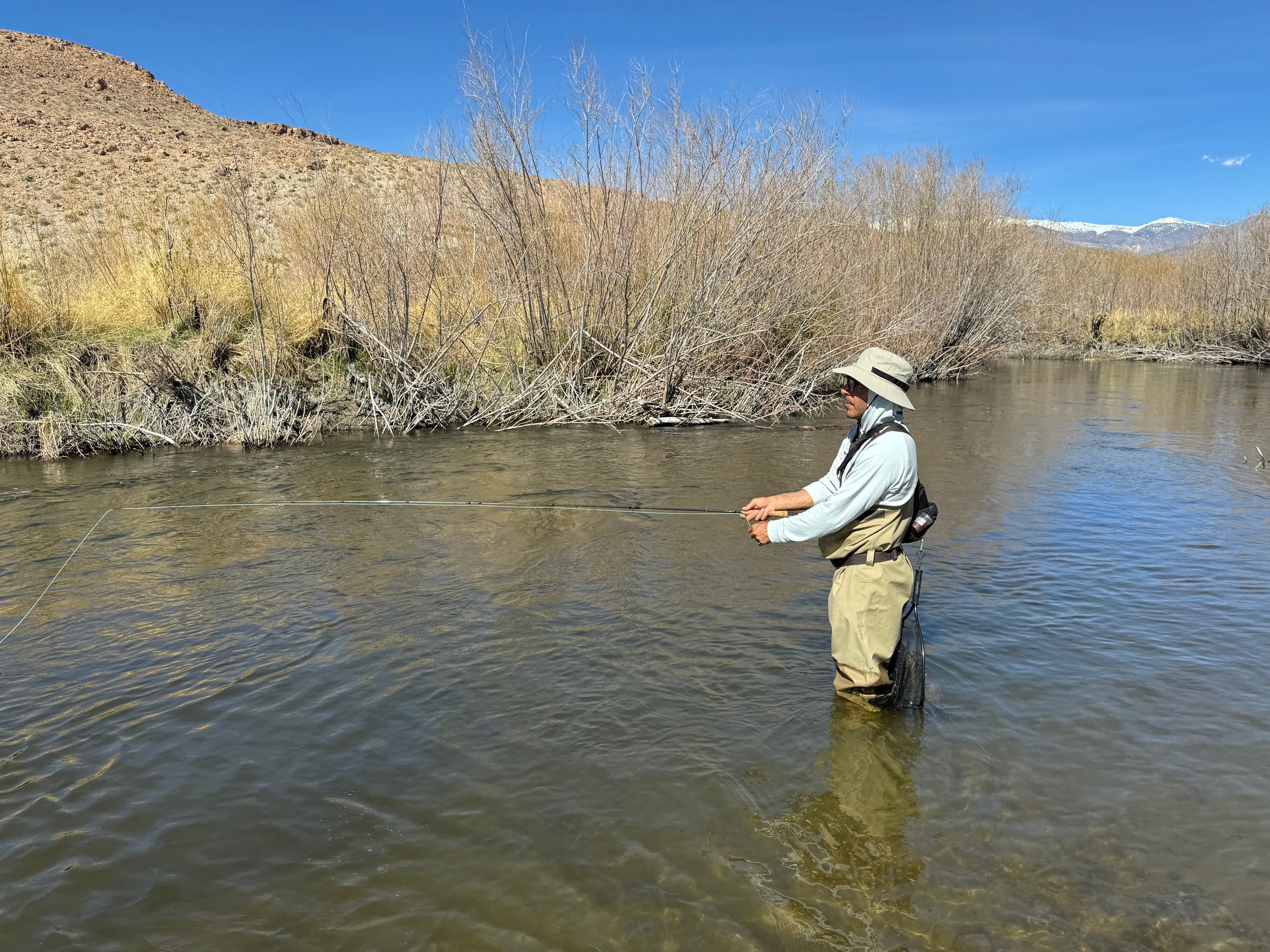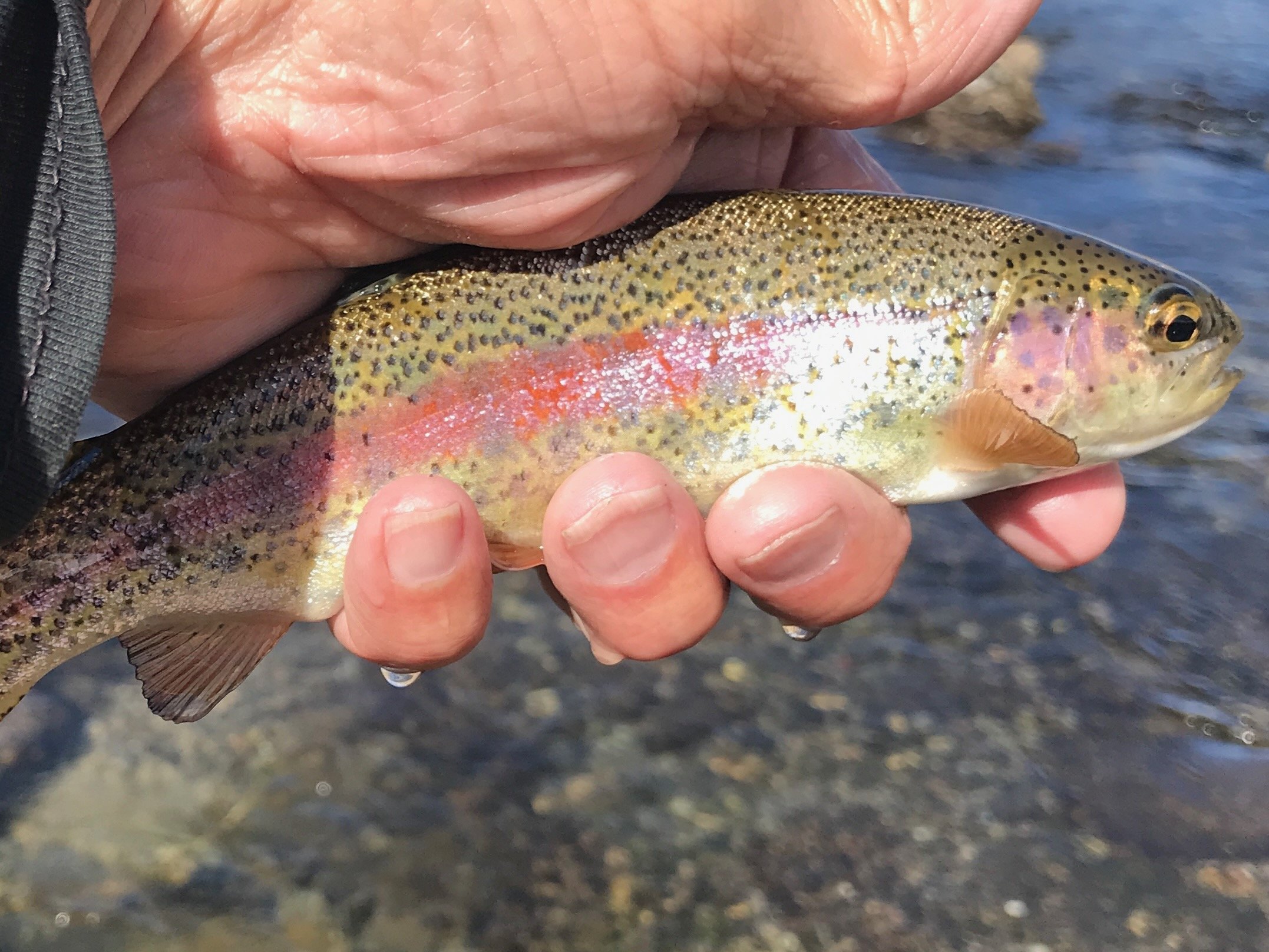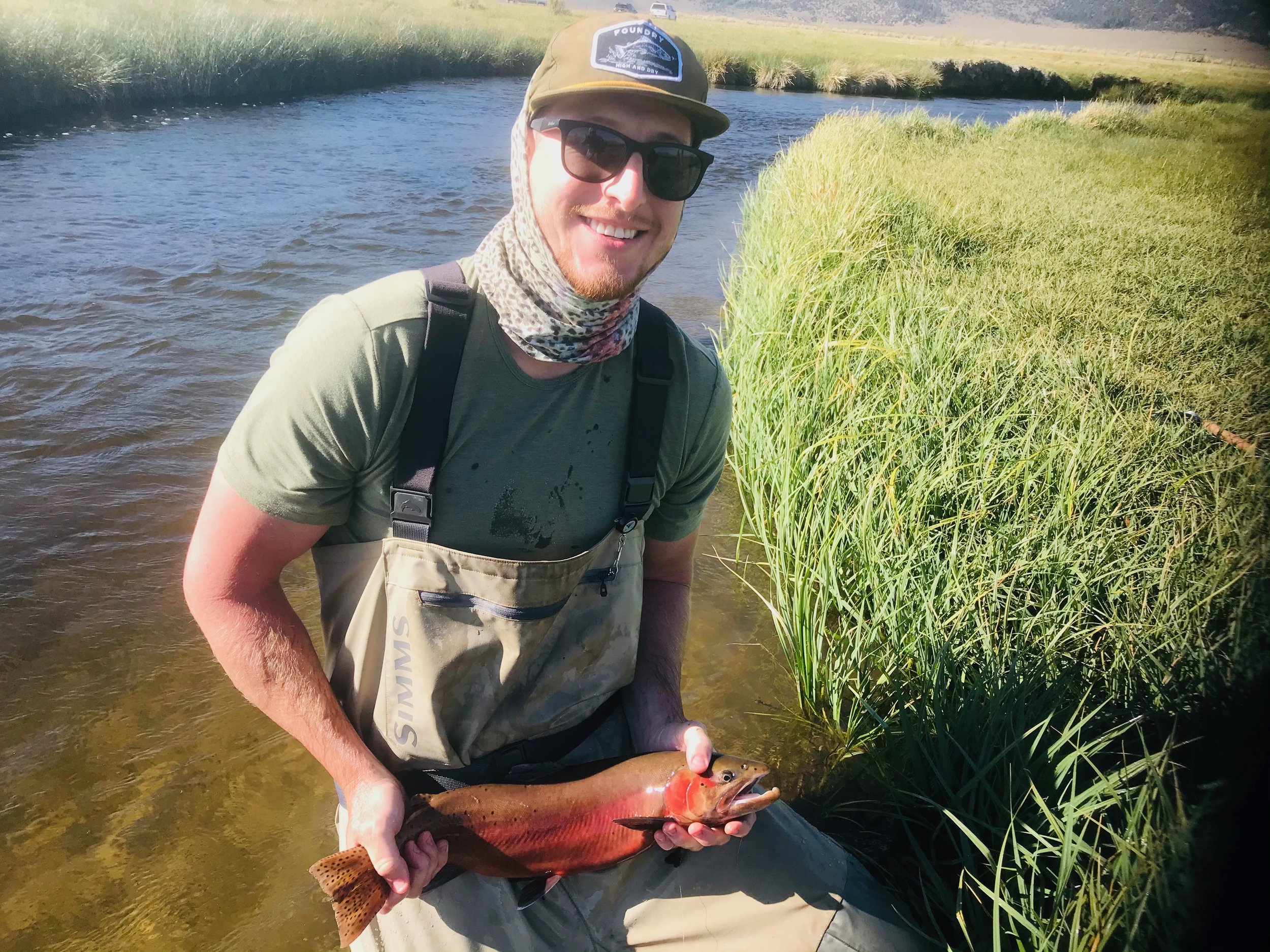Well we traded in the wind and now we are getting the heat. This should warm up the upper elevations and get the last of the snow melting. This should be the beginning of the end of the snow runoff. What’s left to melt off is above the 9,000 foot elevation. When this snow is gone the backcountry waters will be accessible. For those able to do multi day back packs now is the time to explore the backcountry lakes that hold trophy golden trout. June has the greatest number of hatching aquatic insects. For the dry fly purist now is the time to be on the water. Mayflies, stoneflies and caddis flies are the insects the trout are feeding on. Now is warmwater fly fishing time in the Owens Valley as bass, bluegill and carp are getting active and taking flies. Have you booked your June fly fishing trip with Sierra Bright Dot yet?
June is the month with the most hatching aquatic insects like this mayfly nymph.
Owens River Gorge
Middle Gorge Power Plant:
It’s June and the stands of stinging nettles, high day time temperatures and the increased rattle snake activity is enough to keep me out of the gorge till Fall. Dry and dropper rig is the way to fly fish in the gorge for the hearty angler willing to make the trek into the gorge this time of the year. For the dry fly in the dry dropper rig use a size 14 or 16 elk hair caddis or Adams Parachute, or a size 14 stimulator. I run the nymphs on three feet of 4X or 5X fluorocarbon tippet. These fish are feeding opportunistically and will take a number of nymphs. I like size 16 bead head flash back gold ribbed hare’s ears, size 18 bead head flash back pheasant tail nymphs and size 14 copper John’s.
Tenkara Tanuki owner Luong Tam hooked up to a wild brown trout in the Owens River Gorge.
East Walker River
Below Bridgeport Reservoir:
Fly fishing continues to be excellent as a dry fly hatch of blue wing olive mayflies and caddis flies have the trout feeding on the surface. For the dry fly use size 18 blue wing olive parachutes, olive sparkle duns, Adams parachutes, brown elk hair caddis, X-caddis and CDC caddis. Nymphing with an indicator or a Euro rig is producing lots of rainbows and browns on size 18 olive quilldigons, size 18 bead head flash back pheasant tail nymph, hot spot pheasant tail nymphs, size 16 bead head flash back gold ribbed hare’s ears, size 16 soft hackle gold ribbed hare’s ear, size 18 tiger midges and zebra midges. The East Walker river is a great place to throw streamers. Size 2 ,6 and 10 olive matukas, olive or brown wooly buggers, olive sculpins, balanced leeches and olive stump busters.
Brian Chastain with a rainbow trout he fooled with a pheasant tail nymph fished under an indicator on the miracle mile section of the East Walker River.
San Joaquin River
Reds Meadow to Agnew Meadow:
The road to the San Joaquin River is Scheduled to open this Friday June 7th, 2024. Access to the San Joaquin River will be Friday through Sunday. It will be shut down during the week so crews can rebuild the road. There will be extended hours on holiday weekends.
The San Joaquin River is a classic opportunistic fly fishing water that lends its self well to a dry and dropper rig.
Hot Creek
Interpretive Site:
Dry fly fishing is beginning on Hot Creek. The question is going to be if this heat wave moving through California is enough to cause the creek to become high and dirty slowing down the dry fly bite. If the dry fly bite holds out fly fish with size 20 blue wing olive parachutes, olive sparkle duns, Adams parachutes, size 20 gray elk hair caddis and gray X-caddis. Nymph with size 18 olive quilldigons, size 16 bead head flash back pheasant tail nymphs, size 16 bead head flash back gold ribbed hare’s ears, size 18 tiger midges and zebra midges.
Waterflows in Hot Creek are unstable as runoff from Mammoth Creek is changing the water clarity and water flows daily.
Hot Creek
Canyon Section:
This is good Euro nymphing and indicator nymphing water before and after the hatches. Besides the blue wing olive and caddis hatch look for the pale morning duns and the little yellow stoneflies. These are the two biggest aquatic insects that hatch on the creek. Use size 16 pale morning dun parachutes, pale morning dun sparkle nymphs and Lawsons little yellow stone fly. For nymphing use bead head flash back pheasant tail nymphs, hot spot pheasant tail nymphs, bead head flash back gold ribbed hare’s ears, copper John’s and stoner nymphs.
The flotilla of Crowley Lake fly fishing boats can be found in Big Hilton Bay where the trout are concentrated and feeding on midges.
Crowley Lake
North Landing:
Weather is warming up and so is the fly fishing. The fish are in 20 feet of water in Hilton Bay and in the north arm of the lake. The weed beds are starting to develop and fly fishers are working the mud beds around the weed beds. Suspending your midges off the bottom from three inches to 12 inches in the mornings is where the trout are feeding on the midge pupae as they come out of the mud. Later in the morning raise your midges of the bottom as the pupae work their way up the water column towards the surface to hatch. The standard midge patterns are working. Use size 16 or 18 tiger midges, zebra midges, gray midges and albino Barron’s. Shore access is still limited as roads around the lake remain flooded.
Juvenil rainbow trout are feeding on nymphs and adults of mayflies, midges and caddis flies.
Upper Owens River
Above Benton Crossing Bridge:
Juvenil brown trout and rainbow trout are offering the fly fishers lots of action on dries and nymphs. Pale morning duns, blue wing olives and caddis are hatching and the trout are feeding on the nymphs and the adults. For the dry flies fish with size 16 brown elk hair caddis , size 16 Adams parachutes, size 18 blue wing olive parachutes and size 18 olive sparkle duns. For the nymphs use size 18 bead head flash back pheasant tail nymphs, size 16 bead head flash back gold ribbed hare’s ears, size 12 stoner nymphs and size 12 green/gold Prince nymphs.
Hayden Grant learning to fish a nymph under an indicator in Bishop Creek Canal.
Bishop Creek Canal
Behind Bishop Veterinary Hospital:
If you can put up with the heat during the day than Bishop Creek Canal is worth fly fishing. Otherwise try fishing in the early morning and late evening when the temperatures outside are comfortable for people. Waiting for the sun to go behind the Sierra mountains is when you want to fish a size 16 peacock body elk hair caddis. The brown trout are feeding on the ovipositing caddis as they return to the canal to lay their eggs. The fishing is good from the time the sun goes behind the Sierra mountains for an hour or two. Cast the elk hair caddis across and upstream. Let it drift naturally until the fly is dragged across the stream. Though you may get a hit during the drag free portion of the drift, most of the hits will come when the fly drags across the current. If you do not get a hit slowly strip the caddis up stream. If the winds up and causes the fly to be pulled of the water and then slapped back on the water let the fly dead drift down stream for a foot or so. When the hits come they are savage as the trout know the insects do not stay on the water for long.


